A SHINING LIGHT
Fulton Hogan is championing the next generation of female leaders in the infrastructure sector




DOING THE HEAVY LIFTING
Roads & Infrastructure Magazine takes you inside the West Gate Tunnel, one of the largest projects in Australia’s history
BETTER FOR ALL The latest safety and technological developments that are enhancing infrastructure delivery
MAY 2024
OFFICIAL MEDIA PARTNERS OF AUSTRALIA’S ONLY SPECIALIST ROAD MANAGEMENT, CONSTRUCTION AND CIVIL WORKS MAGAZINE

FEEDING IN ALL SITUATIONS. The MT 3000-2 Offset is suitable for classic feeding, but can also feed mix to the side. This is because its conveyor can be pivoted to the left and right by 55°, enabling it to cover a vast range of applications, from “hot to hot” paving and hard-shoulder rehabilitation to backfilling trenches and filling the spaces between safety barriers. It can be cost-efficiently transported to the job site on a low-bed trailer. MT 3000-2 Offset – an uninterrupted, non-contacting supply of mix for more quality in road construction.
WIRTGEN AUSTRALIA Pty Ltd · Lot 2, Great Eastern Highway (Off Ivy St) · South Guildford WA 6055 T: +61 8 6279 2200 / www.wirtgen-group.com/australia www.wirtgen-group.com
A WIRTGEN GROUP COMPANY
The Ultimate All-Rounder! POWERFEEDER MT 3000-2 OFFSET
COVER STORY
7 A shining light
Fulton Hogan is supporting the upskilling and elevation of female team members, exemplified by its almost entirely female civil sub-contractor team.
PROJECT REPORT
11 Doing the heavy lifting Premier Cranes & Rigging are helping to deliver the mega West Gate Tunnel Project.
SOFTWARE
16 The whole package
Reveal has provided a suite of subsurface detection technologies, supporting the delivery of the Eastern Busway project in Auckland, New Zealand.
19 Evolution, Not Revolution
Bentley Systems’ Paul King, Director of Product Solution Engineering, sheds light on what is in store for the technological development of infrastructure applications.
23 Digital Adoption
AUSREO has developed and introduced to market a cutting edge and pioneering software, aiding the delivery of large Infrastructure projects.
TECHNOLOGY
38 Swipe and start
It might look like an ordinary excavator bucket, but the RodRadar red bucket is ground-breaking in the field of underground utilities location.
28 More, with less
The recording and assessing of road data is essential in maintaining a high performing road network. Until now.
31 Setting the standard
The importance of regulatory transport programs, which are playing a key role in the continued success of Australia’s transport network.
34 Seeing more Mooven is guiding both infrastructure projects and general road agencies towards success.
SUSTAINABILITY
36 From trash to treasure
Tyrecycle’s line of crumb rubber products are helping to provide high-quality, sustainable options to the infrastructure sector.
39 Future-proofing communities
An insight into the SAMI Bitumen Technologies’ ethos for community support and sustainability.
INSURANCE
42 Thwarting theft
Underwriting Agencies of Australia is educating the sector on risk mitigation strategies to help staunch machinery theft claims.
MACHINERY & EQUIPMENT
45 On the front foot
Wirtgen has partnered with Strata Worldwide to install compatible collision avoidance technology, helping to improve the safety of HAMM AG rollers.
48 The next phase
John Deere is introducing its 950 P-Tier and 1050 P-Tier large dozer models, which boast advanced visibility and safety features as part of the transition to P-Tier.
51 End of the pothole pit?
The bane of many councils is the existence of potholes in its roads. Repairing them takes time but one machine makes that job much easier.
54 Trailers abound
Avijohn Contracting has been laying asphalt on roads across the Sydney metropolitan area for over 30 years, with help from a major machinery manufacturer.
56 Evolving diversity programs
The construction and mining industry has always been male-dominated, but global equipment manufacturer Komatsu is working to change that.
59 Asphalt royalty
Tutt Bryant has supplied world-class compaction technology to the Australian market since 1986. New equipment is now on the way.
ASSOCIATION PARTNERS
60 Australian Flexible Pavement Association
61 National Precast Concrete Association Australia
REGULARS
4 Editor’s letter
62 Contracts & Tenders



roadsonline.com.au 3
MAY 2024 CONTENTS
Premier Cranes & Rigging has contributed multiple crane models and crews as part of its works on the West Gate Tunnel Project.
Image: Premier Cranes & Rigging.

THE DIFFERENCE MAKERS
ACCORDING TO THE AUSTRALIAN Constructors Association, women make up 12 per cent of Australia’s entire construction workforce.
More companies in the roads and infrastructure sectors are embracing new methods to attract talented individuals from an increasingly diversified and wide employment pool.
But there’s clearly more work to be done, in order bridge the gap in representation. For the May edition, Roads & Infrastructure Magazine celebrates the work being done by inspirational figures across the sector to encourage and support greater diversity, in what remains to be a male dominated industry.
In the cover story this edition, we learn more about Fulton Hogan’s unique approach to diversity and inclusion. Aspiring towards a family-like culture, Fulton Hogan is a pioneer in the infrastructure sector as a Tier One provider. Roads & Infrastructure Magazine sits down with four of its female employees from the Utilities Team, to hear about their journeys, as well as how Fulton Hogan is helping to lay a path for their futures within the sector.
We also celebrate the Australian Flexible Pavement Association’s recent tour of International Women’s Day breakfast events. These breakfasts, across multiple states, united the industry with its calls for greater opportunities and empowerment of women in the construction sector. Fantastic keynote speakers and panel sessions were just some of the highlights of what may now become an annual occurrence for the sector.
We also hear from ResourceCo and Tyrecycle on the recent opening of a new $15 million tyre recycling plant at East Rockingham, in Perth.
This plant will provide a boost for crumb rubber manufacturing throughout the region, on top of Tyrecycle’s existing network of facilities across Australia. Each of these plants is helping to transform used tyres into high quality and sustainable materials for road construction. Hear more about what’s in store for the future of this exciting space.
This and much more in the latest edition of Roads & Infrastructure Magazine.
Happy reading!
Tom O’Keane Roads & Infrastructure Magazine
COO
Christine Clancy
christine.clancy@primecreative.com.au
PUBLISHER
Sarah Baker sarah.baker@primecreative.com.au
MANAGING
EDITOR
Mike Wheeler mike.wheeler@primecreative.com.au
EDITOR
Tom O’Keane tom.okeane@primecreative.com.au
JOURNALIST
Chris Edwards chris.edwards@primecreative.com.au
DESIGN PRODUCTION MANAGER
Michelle Weston michelle.weston@primecreative.com.au
ART DIRECTOR
Blake Storey
DESIGN
Bea Barthelson
BUSINESS DEVELOPMENT MANAGER
Brad Marshall brad.marshall@primecreative.com.au
CLIENT SUCCESS MANAGER
Salma Kennedy salma.kennedy@primecreative.com.au
HEAD OFFICE
Prime Creative Pty Ltd
379 Docklands Drive, Docklands VIC 3008 Australia p: +61 3 9690 8766 enquiries@primecreative.com.au www.roadsonline.com.au
SUBSCRIPTIONS
+61 3 9690 8766 subscriptions@primecreative.com.au
Roads & Infrastructure Australia is available by subscription from the publisher. The rights of refusal are reserved by the publisher.
ARTICLES
All articles submitted for publication become the property of the publisher. The Editor reserves the right to adjust any article to conform with the magazine format.
COPYRIGHT
Roads & Infrastructure Australia is owned and published by Prime Creative Media. All material in Roads & Infrastructure Australia is copyright and no part may be reproduced or copied in any form or by any means (graphic, electronic or mechanical including information and retrieval systems) without the written permission of the publisher. The Editor welcomes contributions but reserves the right to accept or reject any material. While every effort has been made to ensure the accuracy of information, Prime Creative Media will not accept responsibility for errors or omissions or for any consequences arising from reliance on information published. The opinions expressed in Roads & Infrastructure Australia are not necessarily the opinions of, or endorsed by the publisher unless otherwise stated.
4 ROADS MAY 2024


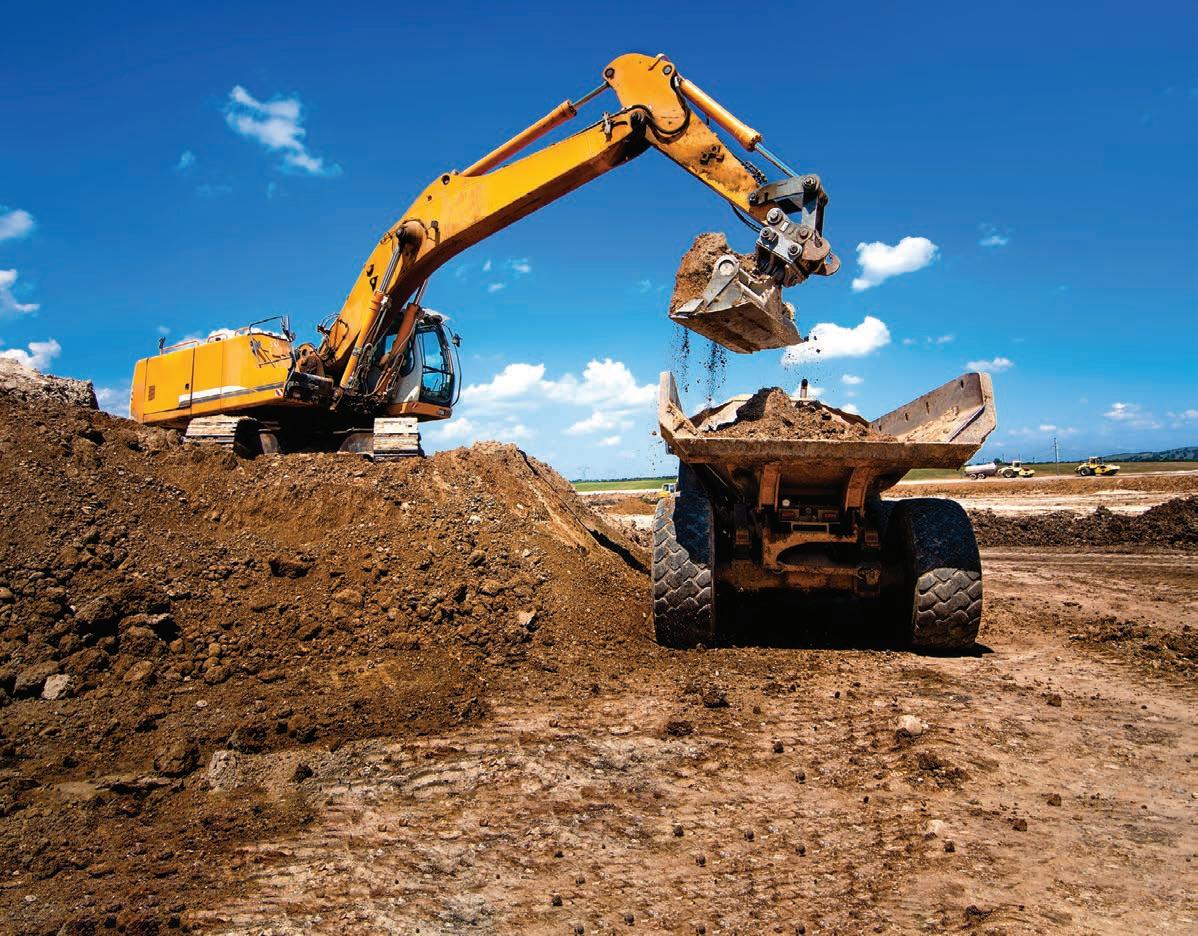














Contact your local dealer today 1300 522 232 www.jcbcea.com.au PRODUCTIVE, COMPACT & AGILE JCB 18Z MINI EXCAVATORS ROBUST 100% steel bodywork for maximum impact protection and ease of repair EFFICIENT Premium, Class-Leading precision hydraulic flow share for ease of use and maximum output SAFE 10 integral easily accessible tie-down points make the transportation process safer and quicker COST EFFECTIVE 500-hour Dig-End greasing intervals to reduce regular downtime EASY TO SERVICE Swing-out counterweight provides unrivalled and easy service access 0% * Only available to ABN holders through CEA Financial Services, provided by De Lage Landen Pty Ltd ABN 20101692040. 0% p.a. based on $10,000 deposit, no repayments for first 6 months, followed by 24 equal monthlies in arrears. Subject to credit approval, terms, conditions and fees apply. Offer ends 28/06/2024 or until stocks last, machine must be purchased and settled by 28th June 2024.The purchase of additional attachments or a trailer may result in a blended rate. OFFER ENDS 28TH JUNE 2024 or while stocks last SECURE YOUR NEW MACHINE AND A GREAT FINANCE RATE TODAY! per annum FINANCE *

A SHINING LIGHT
FULTON HOGAN IS SUPPORTING THE UPSKILLING AND ELEVATION OF FEMALE TEAM MEMBERS, EXEMPLIFIED BY ITS ALMOST ENTIRELY FEMALE CIVIL SUB-CONTRACTOR TEAM BASED IN WESTERN AUSTRALIA.
At almost a century old, Fulton Hogan has always remained at the forefront of modernity, utilising the latest technologies and methods to produce high-quality infrastructure for its clientele.
Fulton Hogan also prioritises the condition and support for its staff just as much as its equipment, an ethos that can be tracked back to the culture and attitudes developed by founders Jules Fulton and Bob Hogan in 1933.
Now spanning 10,000+ staff across both Australia and New Zealand, Fulton Hogan’s emphasis on creating a family-like culture across the business has helped to create equal opportunities for its team members.
The company’s REAL values are just one example. These values of Respect, Energy and Effort, Attitude, as well as Leadership aim to ensure that each individual within the company can feel empowered and supported.
This culture is also helping to internally support and promote Fulton Hogan’s female team members.
SMASHING DOWN BARRIERS
Breaking down the barriers and driving gender equality are goals that many businesses across the construction industry are striving to achieve. What sets Fulton Hogan’s approach apart from the rest?
The company has also worked hard to partner with organisations that are leading
the charge. One example is its ongoing partnership with the Richmond Football Club’s women’s program.
This program assists female players to establish a career in both the AFLW/VFLW and the construction industry, providing opportunities for greater representation across both sport and construction.
Another example is the company’s ‘a day In Her Boots’ program. Aimed at year 9-10 female and non-binary students, the program is set to create awareness around current and future opportunities within the infrastructure industry, showcasing the variety of career pathways available across the sector at all levels.
The program launched in Melbourne last year, following the success of a similar program that’s been running for several years in New Zealand, and will be rolled out nation wide this year.
ON SITE
While aiming to attract the next generation of female and non-binary team members, Fulton Hogan also has an ever-growing representation of female leaders that are helping to shape Australia’s infrastructure pipeline.
A new contract that was taken up last year led to the formation of a new utilities team for works in the Southwest region of Western Australia.
Rebecca Harding is the supervisor of
this team of six, with four of these team members being female. Harding says the work is dynamic and at times challenging, but made easier thanks to the team’s close camaraderie.
“At the moment we’re working on one project, that’s the fibre optic networking. That incorporates the installation and upgrading of pits, as well as hauling and overall upgrades to the network,” she says.
Three crew members within the team are comparatively young and new to the sector.
For Paige Ward – Leading Hand, Mikayla Bulman – Labourer, and Jordie Harcombe – Labourer, this post with Fulton Hogan represents some of their first working experiences out of high school.
For Ward, it was the opportunity to get straight into the workforce during high school, as well as an enticing traineeship program that led her to Fulton Hogan. She says the change has been a positive one when it comes to the team itself, as well as the working environment.
“As part of my apprenticeship, I was doing heavy maintenance. I came back over to the utilities team to complete these works,” she says.
“It’s a bit different, going from working with some of the older guys to a smaller team like this. They can sometimes be a bit grumpy!” She jokes. “It’s good being here”.
Bulman says construction and infrastructure have always been a part of her life. As such,
roadsonline.com.au 7 COVER STORY
Fulton Hogan aims to support and empower greater diversity throughout its entire business.
Image: Fulton Hogan.
working at Fulton Hogan felt more like a natural progression.
“I graduated from high school in 2022,” she says. “I studied a certificate three in health services, so my main goal was to go down that path. But growing up, through Dad, I’ve been around machinery and the sector for a while.”
“I was already friends with Paige (Ward) from high school – we’ve known each other for years. She told me about the opportunity to work at Fulton Hogan, so I just wanted to get my foot in the door to see if I liked it.”
Harcombe originally resided in New Zealand, in a country town outside of Auckland. At the time of joining the business, her mother had already been a Safety Advisor for Fulton Hogan for close to three years.
“I finished high school in 2022 and I was just doing the normal part-time work during that time. I was starting to look into full time jobs and mum was asking around to see what was available. This role came up, so I moved to Perth, originally doing utilities works, then I was transferred down to Busselton,” she says.
“For my first job out of high school, it’s been really nice. I’m used to being around machinery and working long hours from my time on the farm.”
Moving into such a vast and intensive industry may be daunting to some, but all three haven’t looked back, quickly acquiring new skills, while also facing the challenges that come with being new to the industry. Under the trusted stewardship of Harding, all three have so far impressed, both in terms of their attitude, as well as their work proficiency.
Bulman says the size of the team, as well as the similar ages between her co-workers, helped to make the transition to working life much easier.
“I think it’s more comforting coming to work,” she says. “You get to know everyone on a personal level because it is such a small team. It makes it easier being around [Paige and Jordie] because we’re all around the same age. It’s helped to form some friendships.”
Harcombe says she knew of the Fulton Hogan culture through her mother. That being said, she’s still impressed with the support that new employees receive.
“Everyone has been really supportive. There isn’t a lot of pressure because I know that I can always ask anyone in the team if I’ve got any questions. It’s been really great, going from being one of the few females
on other sites, to come here and see other females in good roles – it’s great to see,” she says.
Despite all taking different paths, all six team members are united in their enthusiasm, as well as their already extensive knowledge around infrastructure application.
Harding herself originally worked in horticulture, before having her own landscaping business, and then training people living with disabilities on how to use machinery. Initially employed as a vegetation officer, Harding moved on to supervise heavy maintenance, leading her to the current works.
She says leading the works has been a challenge that she and the rest of the team have been ready to embrace.
“I think the most challenging and fun aspect for this contract is that we’ve all come in on the same level. We’re all learning together and starting to build the team up. It’s something that none of us have ever done before, so there has been some challenges, but it’s been a great experience all being on the same page and learning together,” she says.
along with the installation of thermostat pits comprise of the majority of the teams works, which will soon also include the hauling of optic fibre cables and clearing of blockages to ducts underground. Harding says there’s still two years left on the contract.
“I’m definitely proud of the girls and how far they’ve come. They’ve stuck at it, and they should be proud too of what they’ve achieved so far,” Harding says. “Fulton Hogan has also been really supportive throughout my employment, particularly when it comes to recognising women in construction. I can’t fault them.”
Harcombe says Fulton Hogan’s values are there for all to see, from both micro and macro factors such as the representation of female staff, to the enjoyment and fulfillment on site.
“There’s a standard that everyone gets treated the same, you’re expected to help each other out. It’s just a great working environment. ‘Bec’ has been great as well as a supervisor, she’s always looking out for us,” she says.
“As much as she’s there to make sure we’re doing our jobs, she wants to make sure
“FULTON HOGAN’S VALUES ARE THERE FOR ALL TO SEE, FROM BOTH MICRO AND MACRO FACTORS SUCH AS THE REPRESENTATION OF FEMALE STAFF, TO THE ENJOYMENT AND FULFILLMENT ON SITE.”
To support and assist the team, Fulton Hogan conducted a training program, showing what needed to be completed and how.
Harcombe says the program enabled the team to visually build upon its existing knowledge basis, with a step-by-step walkthrough on project components.
“Being on-site and being given information to read was a big help. I was fortunate enough to have a rough idea around the works thanks to my time in Perth, but I was still quite new,” she says. “It’s been really great to attain that knowledge and have the chance to ask a tonne of questions.”
Bulman says the training played an important part in increasing the overall confidence of the crew.
“It was a big eye opener, actually going up there and seeing how the job gets done. To see how it gets done, it was a little daunting to begin with. But once you get in there and because we have such a good group, that definitely helps,” she says.
Pit removals, upgrades and replacements,
that we’re safe and that we’re having fun and having a laugh along the way. That’s something that we all really appreciate.”
Bulman believes the skills and experiences from this project will play a big part in each of the team member’s futures. Futures that by all accounts, look very bright.
“The skills that we learn every day on the job are benefitting and going towards our future. Getting that experience in the construction industry and getting to know people in the industry could potentially help us out big time in the long term,” she says.
Harding adds that the progress made by Ward has been particularly impressive when it comes to the development of the project team.
“They just get down and get on with the job. The job entails some pretty heavy duty and hard work, but they never complain. I’m proud of all of them and Paige is really coming into her own as the Leading Hand. It’s great to see her confidence grow and develop within herself in that role,” she says.
“I tip my hat off to them.”
8 ROADS MAY 2024 COVER STORY

FEATURES ARE OPTIONAL.



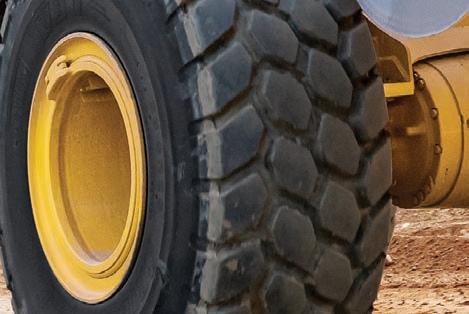











Sometimes you want the latest tech. Sometimes you just want the essentials done exceptionally well. That’s why we offer distinct levels of innovation, comfort, and performance so you can get done faster, more efficiently, and on budget.








JOHNDEERE.COM.AU/WHEELLOADERS SCAN TO LEARN MORE NEVER IDLE 644 UTILITY WHEEL LOADERS
RELIABILITY ISN’T
Komatsu intelligent Machine Control (iMC)
The
future today

Komatsu’s proven intelligent Machine Control (iMC) concept has now penetrated markets worldwide. Thousands of operators and owners enjoy the safety and precision of Komatsu’s exclusive technology, factory fitted on both dozers and excavators, and the outstanding improvement in productivity it brings to the jobsite. Customer productivity is the driving principle behind Komatsu intelligent Machine Control.
Call us today on Sales: 1300 074 249 | Support: 1300 445 978 komatsu.com.au

DOING THE HEAVY LIFTING
PREMIER CRANES & RIGGING’S 350-TONNE LIEBHERR CRAWLER CRANE IS BEING USED AS PART OF WORKS ON THE WEST GATE TUNNEL PROJECT. ROADS & INFRASTRUCTURE LEARNS WHAT IT TAKES TO DELIVER ON SUCH A LARGE PROJECT.
How do you set yourself apart, in such a heavily congested sector?
This question, while asked by many, is often only answered by the few that truly understand what it means to provide a unique perspective and solution within the infrastructure sector.
For Premier Cranes & Rigging, providing the latest technology and experienced crane crews as part of its crane hire service offering wasn’t enough.
Since its foundation 16 years ago, the team at Premier Cranes & Rigging have always stressed the importance of developing a supportive and inclusive company culture.
Referred to as #TeamLifting, this philosophy aims to empower the company’s staff, while also highlighting the importance of each team members contributions in delivering recognised success to its clients.
Kye Giacomin , Head of Business Development – Premier Cranes & Rigging, says this ethos can be felt right through the business, leading directly to higher quality project delivery outcomes, as well as greater client satisfaction.
“Internally we use a system called ‘Bonusly’ where you can recognise your peers. Whether it’s someone at a leadership level, or someone on site, they can equally be recognised for their achievements and their great work,” he says.

“It’s great for morale day to day, and it’s great to see people wanting to achieve even more, regardless of their role in the company. I’ve never seen a system like it. It’s awesome. It all forms part of the larger #TeamLifting attitude.”
This same attitude transcends to the company’s culture around safety and expertise, with internal processes ensuring that all crew members and operators are not only suitably experienced and certified but also acquire the necessary soft skills to diligently handle jobs no matter how
big or small.
Each team member is regularly handpicked for specific projects, based on their previous experience and skillset.
Giacomin says the company’s approach to project delivery is focused on delivering the right result for the end client.
“We go above and beyond, and our approach is consistent, even if it’s a small sized project or something quite large. We can help them internally throughout every department. In some ways we’re a tool. When we’re helping with the management
Images: Premier Cranes & Rigging. roadsonline.com.au 11 PROJECT REPORT
Premier Cranes & Rigging has contributed multiple crane models and crews as part of its works on the West Gate Tunnel Project.



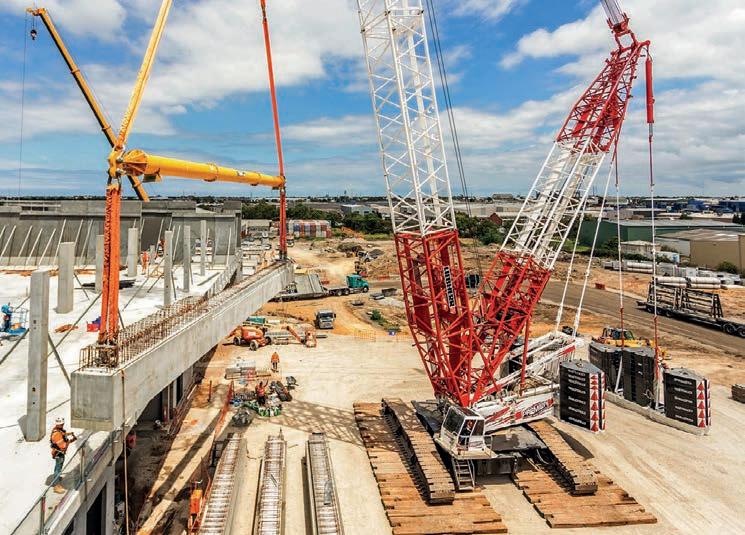
of a project, the client can feel at ease,” he says.
This approach helps to make sure projects can be delivered on time and on budget.
But, Premier Cranes & Rigging rarely rests on its laurels, a key factor in the company’s keenness to get one of its largest crane’s onto its next project.
THE LR1350/1
The company’s vast crane hire options is ever growing, obtaining a crane model that is rarely being used across Victoria.
The LR1350/1 crawler crane comes with a 350-tonne maximum load lifting capacity, making it suitable for major infrastructure
works with diverse lifting requirements. It features a lightweight design, built to increase the ease of transportation and set-up. The crane also features a derrick boom and suspended ballast, for greater load capacity.
Andrew Esquilant, General Manager, Mobile Crane and Crawler Cranes –Liebherr Australia, says the LR1350/1 crawler crane is emblematic of the evergrowing professional relationship between the manufacturer and Premier Cranes & Rigging.
“It’s a very versatile crane. If you had all of the associated parts you could potentially end up with thousands of different configurations that you can put
together. They’ve bought a crane that can tap into a unique niche market in some ways. I think that’s where Premier Cranes & Rigging have done quite well,” he says.
The LR1350/1 also comes with a superlift, helping to increase the stability of the crane during heavy lifts, on top of what is already a stable design, aimed at evenly distributing the operating weight throughout the base of the machine.
The superlift also adds further flexibility to what is already a highly customisable crane configuration.
With client satisfaction at the forefront of their decision-making, Premier has gone a step further to acquire all necessary components to ensure its clients can use any LR1350/1 configuration for whatever their site-specific challenges necessitate.
Esquilant adds that the crawler crane is perfect for tackling the Big Build projects in Victoria.
“The 1350 was designed from our factory to go into a crane fleet similar to the size of Premier Cranes & Rigging,” he says. “There’s a particular focus on assembly and it’s easy to erect from an operational point of view, while at the same time being able to carry out good solid lifts.”
The LR1350/1 is just another in Premier Crane & Rigging’s existing range of Liebherr cranes. Esquilant says the relationship has been developed and grown on trust, as well as a commitment to achieving the best possible outcome for both companies.
“If there are any concerns, we can sit together as colleagues, have a professional discussion, find a solution, and move forward. We both like to keep it real. No matter what it is, we can pick up the phone and talk through it. That’s something that I really enjoy about dealing with a company like Premier Cranes.”
THE WEST GATE TUNNEL
The growth in Premier Cranes & Rigging’s profile as well as its capabilities has resulted in the company becoming a key player in infrastructure works across Victoria.
A core reason for the company’s selection for works on the West Gate Tunnel Project in Victoria, one of the largest infrastructure projects in the country.
The $6.7 billion project, being delivered by the Victorian Government in partnership with Transurban (with
12 ROADS MAY 2024
Premier Cranes & Rigging acquired the LR1350/1 crane over three years ago to support its position as a heavy-lift crane contractor.
Premier Cranes & Rigging working on a key data centre project in Truganina, installing 95 tonne precast concrete beams using the LR1350/1’s superlift for enhanced lifting capacity.

Premier Cranes & Rigging’s works on bridge 73, as well as the West Gate Tunnel Project portals exemplify the company’s capabilities for major infrastructure works.

construction contractors CPB Contractors and John Holland), will establish an alternative route to the heavily congested West Gate Freeway.
This will include widening the West Gate Freeway from 8 to 12 lanes, the construction of new twin tunnels under Yarraville, and deliver a new bridge over the Maribyrnong River, which will join a new elevated road along Footscray Road, providing a new connection to the city’s north and significantly improving efficiencies in Melbournians’ daily commute across town.
It’s during these works on the elevated road along Footscray Road that Premier Cranes & Rigging was able to showcase the LR1350/1.
Antony Feek, Senior Project Engineer –CPB Contractors, first joined the project in September 2021 and has played a key role in the delivery of the West Gate Tunnel Projects steel portals in 2022, as well as current works on Bridge 73.
“I worked with Premier Cranes & Rigging when they provided the steel rigging crew for the steel portals. For the works on Bridge 73, this is where they deployed the LR1350,” he says.
The company’s works, including bridge girders, precast beams and temporary
structure installations have impressed. So much so that the company nominated its 95-tonne bridge girder lift and installation for CICA (Crane Industry Council of Australia) lift of the year 2023 in the over 20 tonnes category.
The lift included the use of the LR1350/1, lifting a 40-metre-long steel girder over the CityLink off ramp, less than a metre from live traffic. This was achieved using a variable derrick, allowing the LR1350/1 derrick to move during the lift and avoid the existing bridge structure during the slew movement.
This represents just one of Premier Cranes & Rigging’s many intricate lifts completed on the project.
Feek says the company has made a positive impact on the project, contributing not only equipment and machinery, but also essential expertise.
“They’ve provided some important resources to the project, from the people on site, as well as their engineers that are doing some of the studies and helping with bookings. They’ve provided a great level of knowledge.”
“Logistically they’ve been a big help, providing a lot of support. That extends to our operation staff, through to our engineers, making sure that any required
changes are able to be implemented on site quickly,” he says.
Giacomin says Premier Cranes & Rigging’s project management-led approach to project delivery is what makes the difference.
“We’ve got a lot of backend support. Through our compliance team, operations team, planning team, as well as our in-house engineers, we can assist our customers as they progress through each stage of a project,” he says.
“With our people being on site, between the field crew and the office crew, there’s a lot of communication between the site group and the audit group. The overall support starts right from the planning phase, right up to execution and delivery. It helps us to fully understand what the customer requires.”
Feek says he’s proud of the teams’ contributions to the West Gate Tunnel Project, saying he looks forward to seeing the end product.
“It’s a proud feeling to be able to see the impact that you’ve had on the site. I’m very much looking forward to being able to drive on it when the projects complete.”
Premier Cranes & Rigging’s Liebherr 350 tonne crawler crane and expert crew is now available for project-based hire.
PROJECT REPORT roadsonline.com.au 13

PEOPLE ON THE MOVE
ROADS & INFRASTRUCTURE HELPS YOU KEEP UP WITH THE LATEST MOVEMENTS ACROSS THE ROADS AND INFRASTRUCTURE
SECTORS.

BECA APPOINTS NEW MANAGING DIRECTOR FOR AUSTRALIA


Beca has appointed a new Managing Director – Australia to drive business growth, commencing 18 March. Based in Sydney, Andrew Mailer joins Beca with more than 15 years’ strategic leadership experience gained through roles in Australia, New Zealand and Canada. Most recently he served as a General Manager at Tetra Tech Coffey, and as Asia Pacific Head of Strategy and Growth at Tetra Tech. Beca Group Chief Executive, Amelia Linzey, said Mailer brings strong leadership expertise to the role and will support Beca’s desire to grow in Australia. “Mailer’s Australian market knowledge and commercial experience, combined with a unique global perspective, aligns with Beca’s strategic priority of growth in Australia,” she said. Mailer said he was eager to begin his tenure and was impressed by Beca’s strong, values driven culture.
Image courtesy of Beca.



NEW LEADER BOOSTS GHD’S TRANSMISSION AND DISTRIBUTION TEAM
GHD has appointed Carl Parlongo as Australia and New Zealand Power Transmission & Distribution Leader to help its clients deliver a step change in demand for reliable and sustainable power networks. The new appointment comes as the Australian Energy Market Operator’s Draft 2024 Integrated System Plan (ISP) predicts 10,000 kilometres of new and upgraded transmission lines will be needed to connect new generation projects to the National Electricity Market by 2050. The Western Australian Government’s South West Interconnected System (SWIS) Demand Assessment also found that Western Power’s network may need an additional 4000 kilometres of new transmission lines over the next 20 years. Parlongo has over 25 years of experience in both business development and project delivery for electricity transmission and distribution services, across power networks in Australia, New Zealand, Asia, the Middle East, and the UK.
Image courtesy of GHD.

ROSS HARPER APPOINTED TO SMARTCRETE CRC BOARD

The SmartCrete Cooperative Research Centre (CRC) has appointed Dr Ross Harper as NonExecutive Director to the SmartCrete Board. Harper is a well-respected senior executive, and recognised leader within Australia’s concrete ecosystem. As a former Group President Operations of Boral Ltd, he brings a wealth of industry and applied research experience to the SmartCrete Board. Over the past decades, Dr Harper has been involved in many concrete-related initiatives and has served in several board and committee positions including Concrete Cement and Aggregates (CCAA), Cement Industry Federation (CIF), and Cement and Concrete NZ (CCANZ). Consistent with his view that meaningful advances in Materials Science are vital to reduce emissions, he was recently MCi Carbon’s (MCi) Strategic Advisor accelerating the implementation of MCi’s siliceous and carbonate products. Harper was nominated for appointment by BG&E as part of the merit-based appointment process for the SmartCrete Board.
Image courtesy of SmartCrete CRC.



14 ROADS MAY 2024
AUSTRALIA’S SAFEST PICK AND CARRY CRANE JUST











Australia’s safest pick and carry crane is now powered by the Cummins Euro 6 Engine, the highest emission control diesel engine available with significantly more horsepower.
Including more powerful front suspension cylinders, lifting capacity has increased by an average of 17% when articulated or working on a side slope and in some cases by over 40% in lifting performance.
The latest Allison Transmission with retarder provides

superior downhill braking, delivering increased safety and control, lowered operational expenses, and reduced noise in urban areas.
The new TIDD PC28-3G is driven by our continuous focus on innovation and actively exceeding expectations for our customers.
Talk to us today to learn more about the TIDD PC28-3G Pick and Carry Crane.


NOW CLEANER, SAFER, STRONGER. TRT Australia TRT New Zealand AUS, NZ, PNG, & Asia Pacific 07 3890 8800 cranesales@trtaust.com.au trtaustralia.com.au tiddcrane.com.au
05.2024 INFORMATION BETTER...
GOT
THE WHOLE PACKAGE
REVEAL HAS PROVIDED A SUITE OF SUBSURFACE DETECTION TECHNOLOGIES, SUPPORTING THE DELIVERY OF THE EASTERN BUSWAY PROJECT IN AUCKLAND, NEW ZEALAND. REVEAL’S TEAM DISCUSS HOW THESE TECHNOLOGIES AND THE PROJECT WILL BENEFIT THE COMMUNITY IN THE COMING YEARS.
The Eastern Busway is one of New Zealand’s largest transport projects, aiming to transform the way locals and visitors travel in and around the region for generations.
The project, which has an estimated total cost of $1.5 billion (per Australia New Zealand Infrastructure Pipeline) consists of four stages, all aiming to improve transport choices and connections in the region.
By 2028, the busway is expected to carry 18,000 passengers daily, more than four times the 3700 bus passengers per day before COVID-19. Despite delays and further cost and scheduling impacts from the COVID-19 pandemic, works on the project are powering ahead.
Major utility relocations are playing a fundamental role in the delivery of these works, an aspect that previously was often a difficult task due to incomplete, outdated and inaccurate utility records.
Reveal were approached by the Eastern Busway Alliance in late 2022 to develop a proposal for the works.
Luke Herlihy, Chief Product Officer –Reveal, says the project presented an ideal opportunity to implement a unified utility model – a new concept being developed by Reveal that combines existing network utility models held by asset owners with the results of geophysical investigations to produce a 3D model of the underground that has been verified to best-practice subsurface utility engineering standards.
“The main Busway is being put in the existing road, and the road is being widened to accommodate this. Utilities need to be relocated from the carriageway into a Combined Services Trench outside of the carriageway,” he says.
“These kinds of large construction projects are really utilities projects with a road on top of them.”
Reveal’s combined hardware and software approach to subsurface detections aims to provide a
comprehensive picture of underground utilities, helping to increase the efficiency, safety and sustainability of works concerning the subsurface.
Utilities such as cables, ducts and piping can all be viewed and clearly identified from a centralised source in Reveal’s platform. Each object in the model has a chain of evidence and “trust score” attached to it, highlighting the sources of evidence and degree of confidence to the detection, so design engineers can make informed decisions about the risks of a particular excavation.
For the Eastern Busway, Reveal used a vehicle with a multichannel groundpenetrating radar (GPR) array to drive over and around the project area to supplement the traditional utility locating workflow.
Jordan Moratti, Project Delivery Manager for Reveal, says the company’s services helped to overcome the biggest challenge for the project delivery authority: the lack of records or knowledge around the location and variation of underground utilities.
“Putting myself in the client’s shoes, not having that firm understanding about what’s underground due to poor quality existing records or ‘unknowns’ from a design perspective, would be quite problematic,” he says.
“As they’re effectively extending the road out and then building dedicated bus lanes, it involves a huge amount of utility relocation. They don’t want utilities underneath the dedicated bus lanes, because obviously if there’s a fault with the utilities or they need maintenance they don’t want to have to shut down these bus lines.
“They’re building combined service trenches, so relocating most of these services to combined service structures. Utilities are a huge element for this project. That’s why they’ve had a real focus on trying to de-risk as much of the underground space, as early in the project as possible.”
Herlihy says these records also play a greater role in ensuring that a project can satisfy other requirements such as safe,


16 ROADS MAY 2024
Reveal’s Underdots technology uncovered the existence of many unknown utilities in the road corridor not present on any existing utility plans.
Images: Reveal.

timely and sustainable project delivery.
“Having that digital 3D model underground will help to improve health and safety outcomes, and importantly, improve the productivity and efficiency of delivering within the tight timeframes that the alliance had to adhere to as well,” he says.
With the assistance of Reveal’s newly launched Underdots data processing service, the Reveal team transformed this raw data set into an easily accessible 3D model for the construction alliance.
Underdots is a software capable of translating raw ground-penetrating radar data into a 3D model, depicting the size and frequency of radar detections through grouped or clustered dots. Solid objects such as pipes, ducts and other utilities can be distinguished from surrounding soil, making Underdots an invaluable visualisation tool for getting quick insights into the underground environment.
Moratti says Underdots fuelled the efficiency and accuracy of the united utility model that was provided to the project delivery team.
“Underdots was a key change, because at the time of the project proposal, we hadn’t developed Underdots as a deliverable, so it was a change from what we initially proposed,” he says.
“The main benefit of that was the ability
to give the delivery authority multichannel array GPR data faster. We did the capture in July and by August we had made Underdots available for the project. The final deliverable wasn’t until December, so traditionally they would have had to wait until we were fully finished to even get a glimpse of what was going on underground with the GPR data.”
This comprises 22.4 hectares worth of mapping within the unified utility model, a significant area covered for works such as this. This model could also be exported into BIM, 12d, AutoCAD and GIS compatible file formats.
All up, 20 per cent of the utilities in the Unified Utility Model were previously unknown assets.
“That [percentage] is standard for works such as this, but it’s fascinating how much in the underground that we just don’t know about or isn’t contained on any records,” Moratti says.
Since delivering this final data set, Reveal has provided ongoing service and support for the project delivery authority, who are actively seeking expertise around the data sets provided.
“We’re still providing answers to their questions around the data in the unified utility model. [The Eastern Busway project delivery authority] is actively doing a lot of potholing or daylighting of the utilities

Reveal’s end-to-end technology and services offering was crucial to the delivery of the final unified utility model in only three months.
associated with the project. There is a bit of back and forth between us just clarifying specific utility information that they’ve found during their potholing,” he says.
“That’s the best quality utility information that you can get – what you can actually see in the ground. The intention is to assist them and help them to understand that information.”
Feedback from the client, as well as other construction partners, further points to the technology’s success.
“That feedback has been really positive. We managed to deliver in the timeframe that we agreed on at the beginning. Even with all the complexities of working around on site with other work parties, we still managed to complete the field works within the original program,” Moratti says.
“The client is really thrilled with the outcome and the data that we presented to them. All of the feedback has been really positive.”
Moratti adds that the potential for wider use of unified utility models, including Underdots, is an “extremely exciting” prospect.
“To be able to do these large-scale utility mapping works and then provide that to a client with a unified utility model provides great value for any project. I’m really excited to be able to undertake projects similar to this,” he says.
roadsonline.com.au 17 SOFTWARE

COMPACT SIZE CAN MEAN
A HUGE ADVANTAGE



CAT® AP400 ASPHALT PAVER
The Cat® AP400 is the perfect machine for those asphalt paving jobs where space is at a premium.


It’s got the compact size, flexibility and versatility you need, especially in built-up urban areas.
Plus, when you purchase a new Cat AP400, you’ll also have the option of:
• access to locally supported parts via the national dealer network
• a comprehensive warranty package



• a Cat Customer Value Agreement (CVA).
To find out more contact your local Cat dealer or visit cat.com/AP400-au










GREAT FLEXIBILITY WITH CONFIGURABLE SCREED DESIGN OPTIONS SIMPLE OPERATION WITH ALL-ROUND VISIBILITY LIGHTWEIGHT AND COMPACT FOR EASY TRANSPORT Service and support options are available from Caterpillar’s independent dealers, at prices and on terms and conditions determined individually by each dealer, and may vary. Contact your preferred dealer for details. © 2024 Caterpillar. All Rights Reserved. CAT, CATERPILLAR, LET’S DO THE WORK, their respective logos, “Caterpillar Corporate Yellow”, the “Power Edge” and Cat “Modern Hex” trade dress as well as corporate and product identity used herein, are trademarks of Caterpillar and may not be used without permission.
NSW/ACT WesTrac 1300 881 064 SA Cavpower 08 8343 1600 QLD/NT Hastings Deering 1300 868 538 WA WesTrac 1300 881 064 VIC/TAS William Adams 1300 923 267 NZ Terra 0800 93 39 39 SCAN HERE
EVOLUTION, NOT REVOLUTION
BENTLEY SYSTEMS’ PAUL KING, DIRECTOR
OF
PRODUCT SOLUTION ENGINEERING,
SHEDS LIGHT ON WHAT IS IN STORE FOR THE TECHNOLOGICAL DEVELOPMENT OF INFRASTRUCTURE APPLICATIONS.
For Bentley Systems, the future looks exciting. With innovative applications already available, such as its iTwin Platform or open design and modelling applications, the organisation is looking to push the limits of infrastructure engineering software.
Paul King, Bentley’s Director of Product Solution Engineering, explains that the development of technologies in this space is an evolution, rather than a revolution, growing on the progress made throughout Australia’s infrastructure sector.
He has seen the application of such technologies on projects first-hand. “I joined Bentley in 2006 during our works with building information modelling (BIM) on the Olympics in London,” says King. “I then spent some time in the Middle East on some big construction projects. Then, we had the Global Financial Crisis (GFC) that marked the start of my journey to Australia. It was interesting to take some of those best practices from big projects outside of Australia, to Australia. A lot of Australian projects and teams are now leading globally.”
King is a part of the Bentley Infrastructure Cloud team, managing the company’s solution engineers in the Asia Pacific region and advising on all aspects of project delivery technology.
This journey to the top has been a gradual progression of improvement and embracing new technologies. As King explains, Australia has come a long way—quickly—when it comes to these aspects.
“In the United Kingdom, we have the ISO 19650 international standard for project collaboration,” King says. “It helps you to standardise how you create and name files. It’s important to manage risk and ensure better outcomes.
“When I arrived at Australia, I came armed
with one of the first copies of that standard. I sat down with four big contractors who were discussing technology. They essentially said, ‘We saw that you did at the Olympics and we want to learn from you.’ I brought this document out and two of the four said that they wanted an Australian standard, not a British one.
“It opened my eyes to the cultural differences between the two countries when it came to technology. Over time, unsurprisingly, more people have been willing to use overseas standards and best practice. That cultural shift has been impactful.”
Bentley has played a key role in opening the door for Australian contractors and infrastructure providers to use the latest in infrastructure engineering software. This focus has long been on getting the technology in the right hands, instead of delivering a blanket solution for everyone.
King said that he has seen this ethos track back to his first contributions on the 2012 London Olympics.
“Since the early part of the century, Bentley has invested in and recognised that it is not just about the software, it is also about how you use it and how you can get people to adopt it,” he says. “From a technology perspective, something that has always been a part of our solutions is the connected data environment.”
The connected data environment is an essential aspect for collaboration on infrastructure projects, connecting project stakeholders from different supply chains into a singular data environment. It represents a space where data and design are shared and accessible by all. It helps streamline changes and alterations to designs, as well as queries around specific design decisions.
“By standardising modelling protocols and methodologies, stakeholders can have information shared easier and across different disciplines and teams,” says King.
King adds that embracing cloud technology is another aspect that has changed in terms of culture. He says Australia is one of the premier users and developers of cloud technology globally.
“Over ten years ago, when I arrived, very few firms were prepared to use cloud services. There was a perception that it was less safe than having a traditional server. In the last three to four years, that’s completely shifted the other way,” he says.
“I think the GFC had a huge impact on this
Paul King, Director of Product Solution Engineering – Bentley Systems.

roadsonline.com.au 19 SOFTWARE
cultural shift. We essentially had to do more with less. Now, there’s a significant shortfall of engineers that we require to tackle the coming pipeline of infrastructure. Everyone needs to recognise how important it will be to do more with less.”
There are already examples of major works in Australia, where this focus of doing more with less has proven to be effective. One example is WSP. Recognising the pivotal role of effective information management and the limitations of previous technology approaches, the organisation sought a comprehensive digital solution that could streamline data management and facilitate efficient collaboration while building trust in new digital workflows.
It needed user-friendly, integrated technology applications that foster a holistic approach to data management, ensure compliance with ISO-19650 standards, and support a widespread digital shift.
Embracing the capabilities of Bentley Infrastructure Cloud, WSP selected ProjectWise and iTwin to address data management, collaboration, and project lifecycle engineering challenges, enhancing decision-making and delivering superior project outcomes. Leveraging Bentley’s applications, design teams can collaborate, visualise, and review the design model in real time.
Using their Port Rail Transformation Project (PRTP) as an example, WSP saved approximately 300 resource hours, reducing rework and the project timeline. By communicating and exemplifying the advantages of digital workflows, the company has instilled confidence in the national business shift to digitisation, driving innovation in enterprise engineering.
“I think project teams and organisations are starting to realise that this is what success looks like–delivering your project on time and under budget. They’re asking themselves, ‘what’s the differentiator?’ Having these examples has been critical,” says King.
“The industry has gone full circle from when I first started in the U.K. The difference now is that these technologies are now off the shelf. People are no longer spending millions of dollars on complex technology. It’s about using that data better.”
Bentley Systems can provide the full spectrum.
“We’ve been creating software to support digital workflows on projects
through the full lifecycle,” King says. “We work from planning and design through to construction, handover, and asset management. We have insight working with our customers in the space around what they need to do, what does success look like to them, and we then design the software to support that.
“It’s not revolutionary, it’s evolutionary. It’s principally adopting best practice wherever you can find it.”
De-risking is another feature of Bentley Systems’ technological offerings. King says it is about getting the best possible information, whether it’s models, drawings, and/or specifications to get the complete set of design information.
“Increasingly, construction teams are saying that they need to work with their supply chain to ensure that the information that they get is complete, correct, and consistent. You can have all that information, but it’s just as important to connect it. That’s where a connected data environment is so important,” he says.
The iTwin Platform is just one specific example of Bentley System’s connective technology. This platform optimises infrastructure delivery and performance
because I can see it and interact with it.”
Bentley applications are compatible with other systems and programs, enabling multivendor-based teams to share their information and pool it without worrying about the file formats.
The organisation will soon showcase these technologies and more as part of its upcoming Bentley Illuminate infrastructure engineering conference. The event will pool together like-minded individuals around the future of infrastructure engineering software and hardware, as well as more efficient methods and processes for infrastructure development.
Bentley Illuminate will also host key speakers who will address themes that include sustainability and infrastructure resilience. The event will also include big players from across the sector, including owner-operators, engineering firms, and contractors.
At the event, Bentley’s Mike Campbell, Chief Product Officer, and Oliver Conze, Senior Vice President for Bentley Infrastructure Cloud, will present a technology vision and roadmap offering a glimpse into Bentley’s exciting innovations and advancements for infrastructure digital
“INCREASINGLY, CONSTRUCTION TEAMS ARE SAYING THAT THEY NEED TO WORK WITH THEIR SUPPLY CHAIN TO ENSURE THAT THE INFORMATION THAT THEY GET IS COMPLETE, CORRECT, AND CONSISTENT. YOU CAN HAVE ALL THAT INFORMATION, BUT IT’S JUST AS IMPORTANT TO CONNECT IT. THAT’S WHERE A CONNECTED DATA ENVIRONMENT IS SO IMPORTANT,”
throughout an asset’s lifecycle. The digital twins can be constantly updated and synchronised to ensure all project stakeholders are on the same page. Streamlining design changes and client communication boosts not only project timelines, but also a company’s bottom line.
Engineering, geospatial, and operational data can all be centralised, while also incorporating real-world conditions to predict future conditions for inspections, reporting, and insights using artificial intelligence and machine learning.
“As a project manager, I can open a web browser to view a full three-dimensional model of that piece of infrastructure,” says King.
“If I’m a project manager, I don’t care if it’s from one authoring application, or six,
twins and artificial intelligence.
Attendees will also hear from Aurecon’s CIO Carl Duckinson, SparkNEL’s Digital Delivery Director Jayson Winchester, and TfNSW’s Executive Director of Digital Engineering Services Devon Middleditch. These executives will provide insight on the challenges they are facing today on their major projects, as well as their perspective on the changing industry landscape.
King will be one of the key speakers at the event and said that it will showcase the progress made so far, as well as a path forward for continual improvement from across the infrastructure sector.
“We’ll be asking how and what can we do better as an industry, as companies, and as individuals. Whether you’re designing, building, or operating, there’s something for you at Illuminate,” he says.
20 ROADS MAY 2024 SOFTWARE
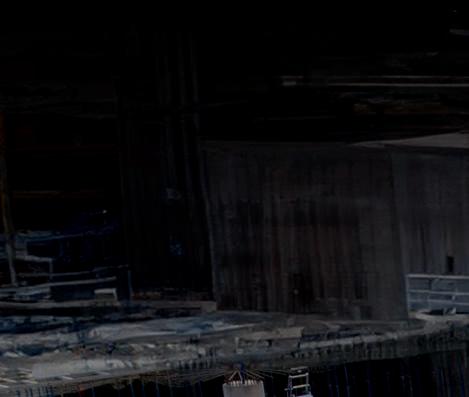
YOUR CHOICE REGULATORY PARTNER
Need assistance with a regulatory program?

Let us open up a world of opportunities as your choice TCA-approved provider for the IAP, OBM, TMA, and RIM programs.

IAP
Increase your payload to instantly boost productivity, turn around times, and profits.

Smart OBM
Increased payload, unprecedented access, and ability to run PBS enabled vehicle configurations.


TMA &



Scan to learn more
RIM Applications that provide a level of balance between compliance & productivity. NHVAS
Digital solutions to help you and your drivers comply with Heavy Vehicle requirements.

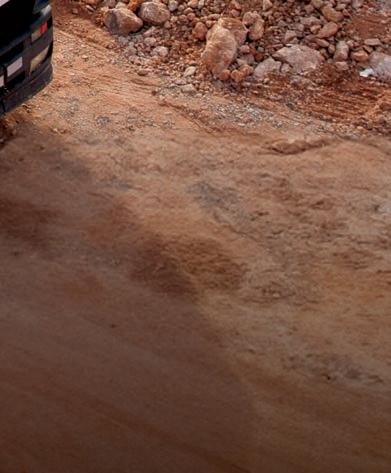


1300 111 477 TeletracNavman.com.au





IN CONSTRUCTION AUSREO’S DIGITAL ADOPTION
OVER THE PAST 10 YEARS, AUSREO HAS DEVELOPED AND INTRODUCED TO MARKET A CUTTING EDGE AND PIONEERING SOFTWARE, AIDING THE DELIVERY OF LARGE
INFRASTRUCTURE PROJECTS.
Building large complex infrastructure projects is made simpler with digital technology and early engagement to provide better project outcomes.
AUSREO represents a blend between industry know-how and IT integration and the company has forged strong partnerships to deliver what is a suite of services dedicated to steel reinforcing. This is more than just utilising off the shelf construction software.
One such relationship is that with ADDA, the developer and distributor of software made specifically for steel reinforcement analytics.
As Paul Barbuto, General ManagerBusiness Development – AUSREO explains, the software has been built by reinforcers, for reinforcers. This is a big plus for AUSREO, who has an exclusive deal in Australia for the use of this software.
“The biggest difference is that this software has been built for reinforcing specifically. Competitor software is basically off the shelf, but this has been tailored,” he says. “We’re not trying to adapt off the shelf software to reinforcing, because we don’t have to.
“This software has also been integrated into our production, operations team and all departmental experts internally, whereas a lot of our competitors will outsource the software and the technical staff. We’ve kept the entire package within our business. We’re the pioneers in this space.”
This technology is useful in ensuring project timelines, budgets and safety is met. It is also designed to make stakeholder engagement and plan changes simple in a controlled environment away from the dayto-day challenges on site.
Working collaboratively is another benefit. Ultimately ensuring engineering and construction companies are optimising expert involvement while embracing software to achieve greater project outcomes. As Paul Lowden, General
AUSREO’s platform is centred around collaboration and innovation, helping its customers to achieve greater project outcomes.

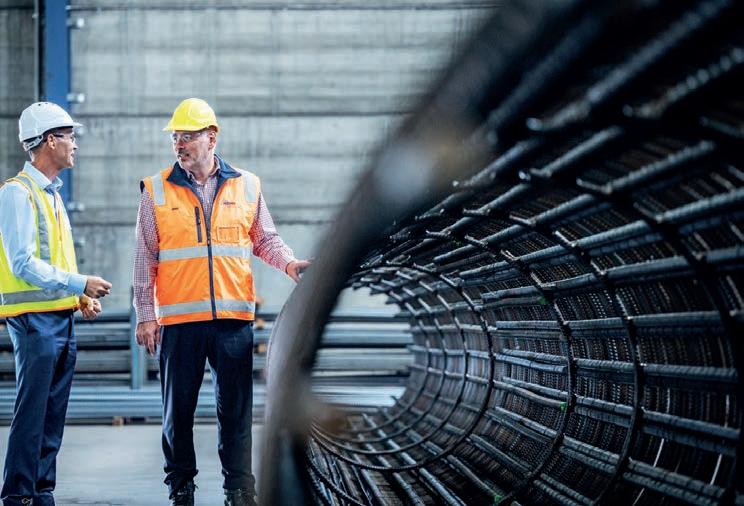
Manager, Construction Solutions –AUSREO details.
“Using our experts in the business, once design commences, we model it in the BIM environment. That’s where we’re talking to the contractors before the job starts, to identify solutions that could provide savings around the project. That might be time savings, material savings, so where they could potentially use less steel for example,” he says.
“Once the job starts, then we look at the project detail area by area, element by element. While our teams are modelling we are simultaneously reviewing those models with the project engineers.
The introduction of discussions around build-ability with site engineers within the modelled environment provides an alternative with a time and cost comparison that delivers value throughout the total value stream.”
This helps project managers and contractors by improving build-ability and increasing the value throughout the project value chain, with savings up to 20 per cent on project time, materials, and waste.
The program, and AUSREO’s approach to project delivery, also create greater connectivity and communication with the material supply chain. Early engagement and collaboration throughout an integrated supply chain helps to identify opportunity, minimises waste and optimises product procurement. This enables a project to be delivered safely, accurately, on time and within budget.
This is achieved by using a virtual twin BIM model. It’s here that users can achieve a greater understanding. Reinforcement lifecycle, combined with a data-rich BIM model of Bar Bending Schedule (bar list), and production understanding of piece count vs tonnes, are the main criteria that establishes the analytics that enable informed decisions to be made.
This includes factors such as forecasting, scrap analysis and waste identification.
AUSREO’s focus on workflow optimisation ensures reinforcement is recognised as a sustainable product on any critical path.
ALL TOGETHER
AUSREO’s places its responsibility to
Images: AUSREO. roadsonline.com.au 23 SOFTWARE


all stakeholders and communities as paramount. The 3D reinforcement model focuses on the design and build-ability requirements that ensure a safe workplace throughout the total supply chain.
Through clash detection, collaborative reviews, simulating reinforcement placement allows collective creation of method statements from the virtual model to ensure safe loading, handling and installation practices are implemented and achieved.
Lowden says the clarity provided by the ADDA software and AUSREO’s services can help to increase the safety and prevent issues arising on site.
“Having the clarity in the data in a 3D sense, within an environment that’s technologically advanced allows communication to be clearer and more accurate,” he says. “Just imagine, sitting at a table with drawings all over the desk, trying to sort out a complex situation.
“We take that issue away. With our model you can talk about it, look at it, zoom in and identify where bars may clash or impossible to place. We can identify those building issues, in some cases before they
Forecasting, scrap analysis and waste identification are just some of the aspects that can be achieved through the use of AUSREO’s platform.
arise. The engineers can come to us and say, ‘we’ve got an issue on site, how can we resolve it together?’ That all starts with this model.”
AUSREO’s software suite and experienced local and international detailers enables comparison of traditional loose bar reinforcement placement against a prefabricated, modular or sub assembly reinforcement solution.
PROJECT PROVEN
Through persistence, professional development, and product invention AUSREO with ADDA has created an integrated software system for infrastructure works.
Its project delivery focused team of 65 professionals can deliver complex projects of all sizes. Using its knowledge and expertise, AUSREO has delivered many iconic infrastructure projects, providing savings of up to 20 per cent.
This includes works on some of Australia’s largest infrastructure projects, such as Sydney’s M4/M5 Widening and Rozelle Interchange project and the Sydney Metro Project.
In Victoria, works on the Melbourne Metro Tunnel including CBD North, South, Eastern Portals and Anzac Station have been completed, on top of additional works on the North East Link.
In total more than 100,000 tonnes of reinforcing steel have been accurately supplied to these projects, plus others where the benefits of AUSREO’s digital and engineering expertise have helped to deliver project success.
Gino Federico, National Sales Manager – Major Projects – AUSREO, says the company was able to impress by providing a
complete, end-to-end solution, rather than an external service.
“As part of our works that recently finished on the WestConnex Rozelle Interchange, we provided reinforcing plus modelling services. There were a number of complex structures, all underground so we did a lot of clash detection and a buildability analysis on different elements,” he says.
“The collaboration that results from this is far superior to what you get from traditional methods.”
AUSREO has pioneered change where the industry can effectively and efficiently look closer at reinforcing steel procurement and delivery. And this has been done alongside several like-minded people from the construction industry to ensure the entire supply chain can build with confidence and maintain sustainable outcomes for the project lifecycle.
Barbuto says it’s time for the sector to embrace the digital world and welcome AI by adopting the digital transformation the industry “so deserves”.
“The more work we do, the larger our library of data gets,” he says.
“Our goal is to create a data-rich encyclopedia or library that can be used to create efficiencies and benefits for future projects. Systems like Artificial Intelligence will start to be introduced eventually to this software. No one in the reinforcing industry is really talking about it, but we are.
“We’re trying to innovate in a noninnovative industry. Construction hasn’t really changed significantly in the last 50 years, compared to other sectors. We’re not going to change that, but at least for the reinforcing supply chain, that’s what we’re trying to change.”
Federico says continued development of both the software and hardware will benefit the sector as a whole.
“We’re continuously investing in the software to push it further. From that point of view, there’s always something in the works,” he says.
“This is the way forward – it’s the future. There’s still some resistance in the sector, particularly for people who haven’t worked in the digital reinforcing space before.
“Generally speaking, the industry is moving towards digital. They want to collaborate digitally with multiple parties and away from traditional methods. Our services, along with the ADDA platform, are that next step that people can take when they come onboard.”
24 ROADS MAY 2024 SOFTWARE
AUSREO has now worked on some of the largest infrastructure projects in the country.
WE’RE HERE FOR THE LONG HAUL.


At Tyrecycle, we are committed to recycling end-of-life tyres otherwise destined for landfill. We are paving the way to produce more Crumbed Rubber Asphalt to cater to growing domestic demand with over $40 million invested in setting up new and upgrading plants, creating long term value for all stakeholders.

MRPV TRIALS LIVE DIG RADAR
This might look like an ordinary excavator bucket, but the RodRadar Live Dig Radar ground scanning technology (pictured above) is groundbreaking in the field of underground utilities location... without needing to break any ground.
As part of Major Road Projects Victoria’s commitment to safety and innovation, its Safety team recently tested the new RodRadar technology, which is capable of locating utilities and prevents service strikes and operator injuries.
In one of the first uses of the system in Victoria, RodRadar was put through its paces in a demonstration on Pakenham Roads Upgrade project site, run by MRPV and Bildgroup.
The device incorporates a groundpenetrating radar (GPR) system within the bucket assembly and can be easily attached to a standard excavator.
One swipe of the RodRadar bucket over the dig area allows operators to assess what is underground beneath the machinery – preventing potentially life-threatening service strikes.
It is radar imaging technology that enables automatic, real-time, on-site alerts, to
prevent damage to underground utility infrastructure during excavation.
Major Road Projects Victoria Senior Safety Manager, Jamie Dineen, says the technology could help to improve the overall safety of infrastructure development.
“It was great to put RodRadar’s Live Dig Radar through its paces with a demonstration on our Pakenham Roads Upgrade jobsite recently,” Dineen says.
“Eliminating underground service strikes on our job sites would decrease delays and additional costs to projects, and this product will play a big part in eliminating most of these accidents.”
The ability of this technology to reduce the likelihood of costly service strikes would see construction progress more smoothly. This can be achieved through limiting delays by accurately and non-destructively locating buried utilities underneath the machinery.
RodRadar Australia National Sales and Marketing Manager Mark McLachlan, says the company’s innovation and development provides a big boost for both underground utility and ground level construction works.
“RodRadar’s Live Dig Radar technology
offers the triple benefits of safety, efficiency and cost-saving,” McLachlan says.
“We are thrilled that MRPV has been testing the Live Dig Radar and will look into opportunities to use the system on their projects.”
“Damaging underground utilities represents significant safety and efficiency risks, and pre-existing utility data can be unreliable. We are excited to deliver a system that enables any operator to avoid utility strikes during excavation, without the need for expert analysis.”
McLachlan adds that the ability to immediately and accurately survey the area underneath the machinery has great potential within the industry.
Operators can dig with confidence, avoiding utility strikes that would otherwise impact project schedules and profitability.
The system is easy to operate and fit to new or existing excavators.
MRPV will continue to trial RodRadar and other technologies across its project sites.
“We’re always on the lookout for cuttingedge technology to bring into our projects to ensure we’re getting them completed as quickly, cost-effectively and safely as possible,” Dineen says.

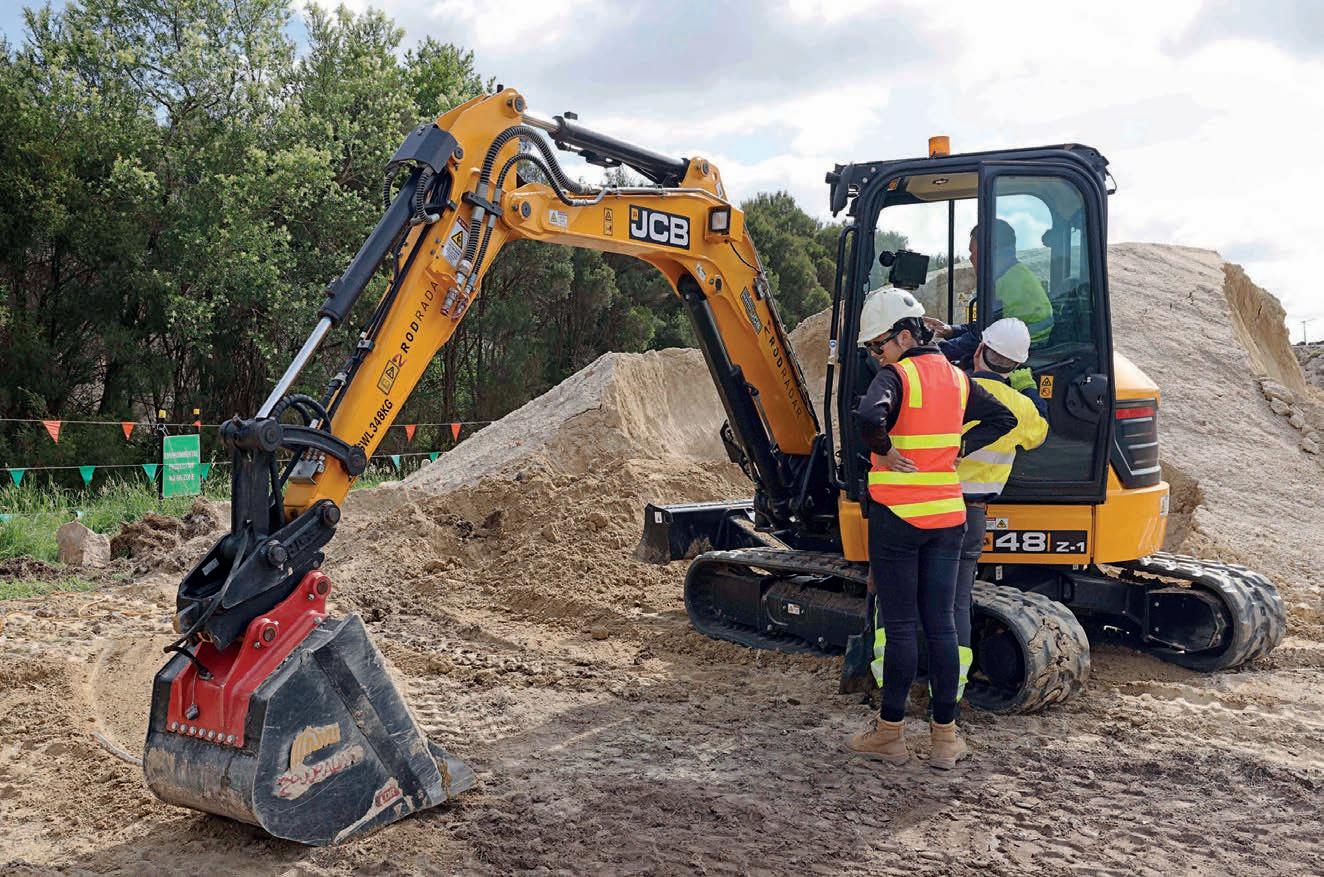

26 ROADS MAY 2024 TECHNOLOGY
The RodRadar technology was recently trialled at Major Road Projects Victoria’s Pakenham Roads Upgrade project site.
Image: MRPV.



MORE, WITH LESS
THE RECORDING AND ASSESSING OF ROAD DATA IS ESSENTIAL IN MAINTAINING A HIGH PERFORMING ROAD NETWORK. MANY FACTORS MAKE THIS DIFFICULT, SO ROADS & INFRASTRUCTURE MAGAZINE LOOKED AT WHAT TECHNOLOGIES CAN ASSIST.

Australia’s network of roads and highways have a length of 873,573 kilometres, making it one of the world’s most vast road networks (Worlddata.info).
Tracking, managing and evaluating the vastness of this road network can be trying, especially in rural areas, where the road network can often be difficult, or too large to track.
Essential resources rely on these roads to be maintained and of a high quality, with agriculture, freight, shops and emergency services all relying on the highways and main roads across the country.
In a landmark report from the Grattan Institute (Potholes and pitfalls: How to fix local roads) released in November of last year, concerns and potential issues around road infrastructure maintenance were placed in the limelight.
With financial pressures and less resources, councils are often unable to fulfill their usual services. And this is happening to
more councils than you might expect, as Civiltech Solutions Founder and CEO Leigh Carnall explains.
“It’s a critical issue. There is a shortfall in funding and other factors that are leading to a lack of data and information that councils require for their road network, as well as grave limitations that councils have in understanding their own network,” he says.
This is an issue that has also been exacerbated by a growing resilience and pressure on councils to deliver a multitude of services.
“Compared to when I started out in local government 23 years ago, there’s been a huge increase in the responsibilities that councils have for the community. There’re more and more things that councils are now expected to deliver,” Carnall says.
“Whether it be implementing legislation from other levels of government, through to local expectations around infrastructure and assets, they are all essential functions of a community. Roads often get neglected,

or councils just go out and fill up a pothole. That attitude is having a big impact on our road network.”
According to the aforementioned report, 75 per cent of Australia’s roads are managed by councils, which includes both sealed and unsealed roads. The Institute estimates that an extra $1 billion is required in the next 12 months just to keep the same roads in the same condition that they’re in today.
But it’s not all doom and gloom. Far from it. Luckily, recent developments in technology are opening the door for councils across the country to achieve far more, with less.
THE
CIVILTECH
DIFFERENCE
Data collection is vital to accurately assessing when and where upgrades are needed. The latest National State of the Assets report showed that less than 20 per cent of responding councils said they base their infrastructure performance data on high-quality evidence. Poor data in many cases leads to poor road quality, longevity,
28 ROADS MAY 2024
Civiltech Solutions’ technology helps councils and road authorities to achieve more, with less.
Image:
Civiltech Solutions.

sustainability and performance.
Civiltech Solutions is hoping to turn the tide by providing affordable, easy-to-use and accurate road and infrastructure mapping. Founded in 2011, the company is responsible for the development of sustainable infrastructure solutions. Its current endeavour, working with Cyvl.ai, is helping to optimise AI technologies to improve project outcomes.
In laymen’s terms, this technology uses sensors to record data and imagery of road asset conditions. It therefore turns imagery into actionable data that can help to influence decisions around upgrade works, repairs and more.
“The Grattan Institute said that funding for many councils has plateaued off. So effectively they’re trying to do more with less. This isn’t working due to the lack of funding backing that up,” Carnall says.
Cyvl.ai’s sensor can be mounted to any vehicle, ensuring that the technology is easy to install and non-invasive. Once installed on the roof of a car for example, the sensor –along with Cyvl.ai’s AI algorithms – evaluate factors such as pavement conditions, pavement markings and signage.
“With the Cyvl sensor we use computer vision to detect the cracks and potholes down the road. Uniquely we’ve also integrated LIDAR radar into the sensor. The AI will look at the data sets to differentiate between a shadow and a pothole for example,” Carnall says.
“By using the AI, the system is much more accurate. Plus when you’re looking at road cracking, what typically happens is water gets into the pavement and starts to weaken the base course layer. Every time a car goes over this, water squishes into the pavement.
Now with LIDAR radar, it’s easy to detect this cracking using computer vision.”
This information can be viewed in actionable reports within days, with the process of completing field surveys being up to 10 times faster than traditional methods.
Currently, this technology is being adapted to the Australian market, a task that is gathering momentum as both companies eye a widespread release across the nation in the coming months.
“Whether you’re in a regional council or a metropolitan council, there’s benefits across all levels when you utilise technology like this. Even if you don’t have a current roadmap, this is a great way to start your blank canvas and build up that pool of data,” Carnall says.


A new report from the Grattan Institute indicates that some councils are under resourced and unprepared to adequately care for their respective road networks.


“Even for those who might have a deep understanding of their road network, it’s fantastic to gain additional information, especially for assets that may have been too expensive to record previously. We can collect all of that and more, all in one pass thanks to this technology.”
Carnall says that for some the technology needs to be seen to be believed. It’s making an impact already in the US and soon Australia.
“I love going out to councils and talking about asset management, talking about roadways, showing them what this magic black box can do. It does seem like magic,” Carnall says.
“I’m passionate about what this technology means for the nation. Once we start collecting this information on a regular basis, the thought of what we’ll be able to achieve with this information is really exciting.”
roadsonline.com.au 29 TECHNOLOGY
The Cyvl.ai’s sensor uses Artificial Intelligence to increase the quality and accuracy of road network management.
Image: Civiltech Solutions.
Image: stock.adobe.com/ bilanol.


BF200C-2 and BF300P-2: Innovative Solutions To Transform Road Construction
Discover the future of paving with Tutt Bryant Equipment’s BF200C-2 and BF300P-2 pavers, leading an extensive lineup. The BF200C-2 excels in tight spaces, offering unmatched versatility, efficiency, and ease of operation with a minimum paving width of 1.10m.
For larger projects, the BF300P-2 extends capabilities up to 5m widths, featuring MAGNALIFE heating for rapid, even heat distribution. Both models underscore a commitment to performance, maneuverability, and maintenance ease. Choose Tutt Bryant Equipment for comprehensive paving solutions that blend innovation with reliability.


Brisbane | Sydney | Melbourne Adelaide | Perth tuttbryant.com.au 1300 658 888 Follow us on:

STANDARD SETTING THE
TELETRAC NAVMAN’S JAMES FRENCH TALKS ON THE IMPORTANCE OF REGULATORY TRANSPORT PROGRAMS, WHICH ARE PLAYING A KEY ROLE IN THE CONTINUED SUCCESS OF AUSTRALIA’S TRANSPORT NETWORK.
Regulatory Telematics has become an essential aspect of managing Australia’s national road network, providing road managers and regulators with essential and accurate data.
Teletrac Navman was there at the beginning of the Regulatory Telematics space, since the development of the National Telematics Framework between 2003 and 2008. It’s companies like Teletrac Navman, along with government and public sector enterprises such as Transport Certification Australia (TCA), that have turned this space into what it is today.
The TCA oversees research, consultation, and assurance services for the national transport network, covering how technology can support road safety, transport efficiency, freight productivity, asset management, and sustainability.
The NHVR, or the National Heavy Vehicle Regulator, is the peak body that monitors and manages these programs by
administering one set of laws across the states (except the NT and WA). It also acts as an approval body for businesses that are interested in joining said programs.
These bodies, which manage road network programs, establish and provide schemes that give back to industry while also gathering essential resources for the sustained success of Australia’s transport network.
As the longest-serving certified service provider with the highest level of type-approval in the country, Teletrac Navman traces its footprint back to the first ventures into this space, seeing the impacts of the IAP (Intelligent Access Program) closely followed by the OnBoard Mass programs that followed. This was the catalyst for the development of today’s programs, such as TMA (Telematics Monitoring Application) and RIM (Road Infrastructure Management). These programs allow road authorities
and government to access accurate and timely data and the use of road infrastructure, measuring factors such as traffic volume, road condition and peak traffic use. For the business, though, it provides a range of benefits from road network access and unlocks vehicle configurations previously unusable, even increased payload.
By measuring these milestones, data can be used to optimise the management of Australia’s national road network.
Teletrac Navman’s Solutions Specialist, James French, says this increased swing towards regulation provides several opportunities and advantages for a number of people associated with the programs.
“We’re starting to see a drift towards more regulatory compliance in infrastructure, which has been growing in transport for a long time,” French says.
“If you look at transport, you’ve got the IAP, which allows you to carry heavier loads. Similarly, RIM or the Road Infrastructure Management side, gives a lot of data on traffic – the volume of traffic going down particular streets – that way they can see the impact that projects are having on the surrounding infrastructure.”
Importantly, these programs also provide benefits to the participants themselves. In return for enrolling and complying with permit conditions and program criteria, businesses can receive increased payload and access on the road network.
roadsonline.com.au 31 TECHNOLOGY
Image:
Teletrac Navman.
Regulatory transport programs play a key role in sustaining, enforcing and maintaining when it comes to Australia’s national transport network.



“For every truck or other vehicle on these programs compared to not being on the program, the benefit is significant. It’s not just payload, you can get exclusive road network access and make freight drop offs a lot quicker,” French says.
To unlock these benefits, the first step is acquiring the ability to record and prove. Telematics is key here— technology such as this helps to improve safety and streamline logistics regarding vehicle movements, a critical aspect of satisfying regulatory transport program requirements.
While these requirements can often be confusing to navigate, Teletrac Navman has established a devoted service to cater to this area, assisting customers and the industry in satisfying requirements.
“RIM is one example of an area that Teletrac Navman really excels at on the compliance and regulatory compliance side of things,” French says.
“We have a dedicated team that is there to help customers with regulatory programs, the schemes within, and most importantly, the telematics required. This ensures that we’re on top of everything to make sure that our customers are as well.”
Teletrac Navman offers various solutions on the ‘Certified Service Providers’ list, which dictates what service providers and products can be accepted as part of the outlined requirements of programs such as RIM, IAP and more, as well as helping with region-specific requirements that can differ from state to state.
“If you can imagine, these programs (IAP, RIM and TMA) dictate a set of requirements for the operator to meet. Within these are multiple schemes, each designed to meet different goals that have emerged from the industry’s requirements,” French says.
“As an operator, you have the option to pick and choose which scheme you want. That’s where you need to adhere to the requirements of the program of which the scheme sits under.”
Being on this list of certified service providers is no easy feat, with only eight companies (including Teletrac Navman) listed as of December last year.
The TCA and NHVR help establish the key rules around the regulations across Australia, with the Northern Territory and Western Australian being exceptions.
“We’ve got a long history of proving productivity, efficiency, and success in this space. And with that expertise, you’re able to utilise these schemes to do more, while using less.”
One example of Teletrac Navman’s solutions in this space is its AI-powered IQ Camera.
“From this one video telematics device, you can access the general list of telematic features, data, and analytics of a fleet management platform, on top of the benefits of being able to join a TMA or RIM scheme. If a company is looking for a low-cost entry into these programs, this is ideal for you,” French says.
If the requirements of your objective in
a regulatory program are more stringent, then there are further options that allow for entry into the IAP or Smart OBM programs. When any of these typeapproved devices are paired with Teletrac Navman’s TN360 software, they offer transport customers an AI-powered fleet management solution. This helps to ensure drivers and vehicles are operating safely and efficiently through high-definition GPS tracking, real-time vehicle updates and customisable data and analytics.
French says the benefits of embracing applications such as RIM, TMA and IPA are clear to see. All that’s required is to take the first steps, by contacting the National Heavy Vehicle Regulator to learn more about your objectives, even utilising the NHVR’s route planning tool.
“The benefits are obvious. If you’re already an existing customer, all that’s required is to get your approval for the permit, that is if you’ve already got the technology installed and ready to go,” he says.
“We’ve got the latest, advanced technologies for whatever you need to get started. We’ve been leading in this space for a very long time. We’re constantly in research and development to allow for the future of these programs as well.”
If you are ready to maximise the efficiency of your next project while improving on-road safety outcomes and community relations, then have a chat with one of Teletrac Navman’s Industry Solution Specialists.
32 ROADS MAY 2024 TECHNOLOGY
By measuring milestones through regulatory transport programs, data can be used to optimise the management of the national road network.


With Reveal, you can eliminate subsurface risks, deliver infrastructure projects faster and minimise cost blow-outs and variations.
If you need to understand your underground, get in touch with the world’s leading subsurface experts.
WWW.REVEAL.NZ
REVEAL ARE AUSTRALASIA’S INNOVATIVE SUBSURFACE EXPERTS.
SEEING MORE
MOOVEN HAS PLACED ITSELF AS AN INFLUENCER IN THE COMPLIANCE AND MONITORING SPACE, GUIDING BOTH INFRASTRUCTURE PROJECTS AND GENERAL ROAD AGENCY DUTIES

Why do construction projects often exceed cost and time targets?
Financial pressures, skilled personnel and materials shortages and other factors all play their part. But so does a desire to reduce community disruption when paired with a lack of actionable insight on current road conditions or the real traffic impacts
Mooven, a performance monitoring, program optimisation and community engagement platform, was founded upon this premise. How can we work faster and reduce delays by better aligning construction to the needs of cities?
The company focuses on providing a platform by which both government and public contractors can have more accurate and informative project data, helping to minimise the impacts from unforeseen events, as well as associated complexities around project delivery.
Mooven Co-Founder and CEO, Micah Gabriels, says this fine balance can often topple over, especially in metropolitan areas.
“In a city like Melbourne, there’s a lot of tension you can feel between getting major infrastructure works done efficiently and living in the city at the same time,” he says. “Typically, if there’s concern about traffic impacts, the status quo is to push construction activity outside of busy times.
“The problem is, the information used to make these decisions is often based on annual traffic assumptions across entire cities. Plus a fear of disruption, the unpredictable nature of cities and often lengthy construction times force a set of rules tailored to worst case scenario. Why should we care about this? Inefficient delivery increases costs and timeframes. Our customers frequently reduce project durations by 50 per cent or more by simply using a rich and accurate understanding of
software and hardware offerings are helping to increase the accuracy and effectiveness of infrastructure monitoring and reporting.
the conditions to tailor their work to the specific location.”
“That’s the really fun part, putting leading data, AI and technology in the hands of delivery teams so they can work smarter each day is a game-changer. And a shift that is disproportionate to other initiatives.”
Mooven’s technological portfolio can provide a service that enables both government and public contractors to better measure important factors around their worksites. This can lead to opportunities that may not have been previously available, to create important savings in project cost and the time required for completion. Most importantly, creating trust and confidence across parties.
“We’ve been developing this approach, where we can grab data from a wider range of sources to truly understand what is going on, and why,” Gabriels says. “We overlay the data teams use today with connected
34 ROADS MAY 2024
Mooven’s
Images:
Mooven.
vehicle data for live traffic, information on public transport routes and broader context like how many businesses are nearby when they’re open and events.”
“You can get a really rich picture of why the city is busy, as well as [importantly] predict if it’s going to be busy in your location in the future. It’s completely changing the game for people.”
“The true enabler for change though is being able to accurately monitor what is actually happening during delivery. Without this compliance trail, you can’t build trust amongst the wider range of stakeholders involved in these projects.”
Mooven has embraced a no-hardware approach using what’s known as ‘floating vehicle data’ to help customers more quickly, reliably, safely and cost-effectively get the information they need. This has resulted in the replacement of Bluetooth technology as the primary and preferred source of gathering traffic and site condition data.
This approach has also been verified by the Department of Transport and Main Roads in Queensland, which certified that Mooven’s floating vehicle data approach was not susceptible to the same data gaps that have been seen in Bluetooth data.
Gabriels was quick to point out that hardware still plays a valuable role.
“We use a wide range of hardware, it’s just about picking the best tool for the job,” he says.
Mooven software and hardware have been used in New South Wales, Victoria, Queensland, Western Australia, South Australia, the Australian Capital Territory, New Zealand, and the United States.
Interestingly, Gabriels explains that there is still some resistance to what he explains as a more holistic and ideal solution to the demands being placed on construction staff as a result of Australia’s infrastructure pipeline.
“It’s a really interesting journey. There’s great intention and widespread belief in the adoption of technology to address the sectors’ challenges and to catch up with other industries. However, this butts heads with inertia and a current system that penalises people from stepping outside of the box –ticketing processes – that most people would say over a beer, do a poor job of achieving the desired outcomes,” he says.
One aspect of this innovation is the intelligent management of incidents, events and network performance.
“If I’m the paving manager doing asphalt, how do I decide when and where I’m going
to work? We can look at the traffic behaviour and what’s going on. We can look at the weather. We can look at all these different inputs that are really relevant to the sector,” he says.
While there may be a considerable amount of data pooled, Mooven’s goal is to continually work to increase the simplicity and accessibility of its data, ensuring that staff in different roles and organisation types can all understand the projected implications.
Mooven’s platform also allows live conditions to be monitored against project KPIs, with monitoring also removing the need for site visits in some cases.
“We’ve been putting a lot of time and resources into our reporting. We’re using a lot of graphs and profiles that people are familiar
CoFounder and CEO, Micah Gabriels.
of compliance technology and monitoring than the United States, but just short of the United Kingdom. Mooven has experience in all three markets.
Gabriels says international best practice has shown there’s still room for growth, but Australia remains to be quite progressive in this area.
“There’s already been some amazing results with individual projects and individual customers, some have been able to reach transformational results,” he says.
“We’re now working to unlock the benefits of plumbing multiple contractors and programs of work in a city, into an intelligent ecosystem that unlocks wider value for all parties.”
Gabriels says this also applies to other

“We’ve also started using generative AI to produce clear summaries. AI helps turn data and insight into a simple sentence in plain language that’s really easy to understand.”
Gabriels says there’s an opportunity for standardisation across all states and territories, which would help to establish an even playing field and universal application of compliance and monitoring equipment.
“Everyone is trying to achieve the same thing, they’re just doing it all in a bespoke way themselves and not sharing. There’s definitely an opportunity to standardise across the board,” he says.
“That’s what gets us really excited about the sector as a whole, is having that ability to share data and have more integrations between more of these systems. The challenge is getting everyone on that treadmill together.”
Despite this disconnection, Australia is still poised as a greater embracer and user
so they adjust their plans accordingly.”
“We see this as a way to drive change from the bottom up. Rather than trying to push top-down coordination in a sector where tomorrow can’t be predicted or controlled, it’s about giving the people – delivering thousands of jobs – operational intelligence and simple next actions. Being smarter and more coordinated would transform so much of what we do, and how we do it.”
Mooven’s approach centres on giving people who may typically be informationpoor, the perspective they need.
“It’s like being on the side of a road, seeing as far as you can, but never being able to see around the corner. Now you can,” Gabriels says.
“It’s really exciting when you think about this innovation, not just the technology itself, but seeing how that comes into place and how it fits in a real-world application. I’m fascinated to see where it all leads.”
roadsonline.com.au 35 TECHNOLOGY
Mooven
HITTING THE ROAD RUBBER REALLY
TYRECYCLE’S LINE OF CRUMB RUBBER PRODUCTS ARE HELPING TO PROVIDE HIGH-QUALITY, SUSTAINABLE OPTIONS TO THE INFRASTRUCTURE SECTOR. THE OPENING OF A NEW PRODUCTION FACILITY IS SET TO CREATE FURTHER MOMENTUM.
Rubberised road products have come a long way since in Australia they were first introduced in the 1970’s.
Produced using recycled rubber from end of life tyres, crumb rubber can be used as a substitute to virgin materials for road surfacing and spray sealing, as well as road construction.
Tyrecycle has been one of the pioneers in the recycled tyre space, developing, researching and funding projects and products to create greater quality mix designs.
It’s parent company, ResourceCo, is another dominant figure in the recycled materials space, arguably Australia’s most diversified recycler. ResourceCo specialises in recycling construction and demolition waste into aggregates and base coarse paving products for use in civil construction and infrastructure projects; the remanufacturing of commercial and industrial
waste into a carbon emission combatting alternate fuel source; as well as an being one of the industry leaders in the reuse and recycling of soils.
Jason Campbell, National Sales Manager – Tyrecycle, says the work of everyone in ResourceCo is all centred around maximising the potential of all waste material.
“While the waste streams that the ResourceCo Group handle are wide ranging, there’s a genuine unity and desire to ultimately deliver improved sustainability outcomes, particularly within the construction sector. We’re all constantly striving to produce the highest quality product possible. Doing so provides our customers with the best offering, and it rightly positions the recycling sector well as a credible alternative to virgin materials.”
Campbell says.
Tyrecycle collects in the order of 20 million tyres annually, with a recycling rate of 99 per
cent. On top of its highly decorated tyre derived fuel product, Tyrecycle is immensely proud of the high quality crumb rubber its now capable of producing across Australia.
“We’re the leading tyre recycler in Australia. We only use the best equipment available for our crumb rubber line,” Campbell says.
In a major milestone for the companies, Tyrecycle recently launched its new $15 million tyre recycling plant in East Rockingham, Perth. The plant is expected to have the capacity to process over 40,000 tonnes of end of life tyres, including 7000 tonnes of crumb rubber production. This will increase capacity and access of crumb rubber for Western Australia.
“There isn’t another tyre recycling facility in the Southern Hemisphere that’s anywhere near the same scale, with the same level of technology,” Campbell says.
Campbell says it’s no coincidence


Images: ResourceCo.
The new $15 million facility will provide a significant boost for crumb rubber demand in Queensland, as well as the east coast.
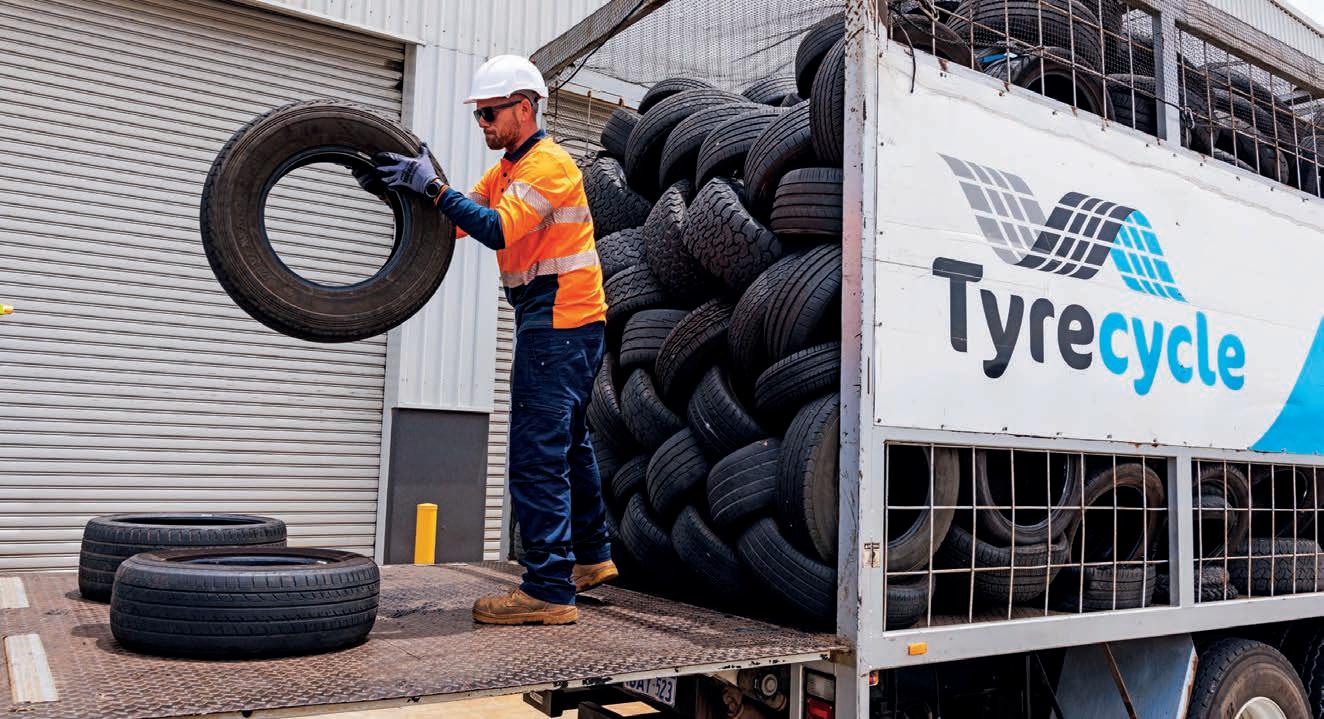
that Tyrecycle’s enhanced rubber crumb capability comes at a time when infrastructure sustainability and associated carbon emissions are prevalent considerations.
“Our independently commissioned research shows that using crumbed rubber in roads, in place of virgin material, represents greenhouse gas savings. Whether our rubber crumb is used in asphalt mixes or in spray seal, the sustainability of road infrastructure can benefit as a result of these applications,” Campbell says.
Backed by a government grant that formed part of the Recycling Modernisation Fund (national initiative to expand Australia’s capacity to sort, process and recycle waste), planning began in 2021 for the new facility.
“The Western Australian Government has done a great job of supporting the growth of crumb rubber for road construction across the state. This year we expect that we’ll supply –and the demand will be –for at least 3000 tonnes. We expect that demand to grow between 9000 to 10,000 tonnes in the coming years,” Campbell says.

Tyrecycle

crumb rubber. We also opened our Sydney facility about two years ago at Erskine Park that also produces 7000 tonnes annually too,” Campbell says.
Campbell says the future of crumb rubber is a bright one, with more research, development and production happening right now than ever before.
“Our facility right now has the capacity to produce 7000 tonnes, all from a locally based manufacturing plant. The fact that it’s based locally also means that it’s cheaper to transport and order for projects and infrastructure providers that are also based locally.”
The newly opened facility will also have a positive flow on effect for crumb rubber production along the eastern coast, regions where the uptake of sustainable and recycled materials is growing exponentially.
“Throughout our network of sites, we’ve managed to accumulate almost 30,000 tonnes of crumb rubber capacity in total. We want to have the capability to keep up with the uptake of this recycled material going into the roads sector.”
Campbell is confident that this near 30,000-tonne capacity will cater for the growing needs of the market for years to come.
“Such has been the uptake, I believe demand will drive our market share beyond current capacity constrains in the next two to three years. We’ll seek to increase our capacity again if that happens,” he says.
“It’s really exciting for us to now have an additional facility and potentially more in the medium- to long-term future. Being able to provide locally manufactured crumb rubber across three states, giving us and customers easy market access around the country, is a real positive,” he says.
“I’m really proud of the increased volume of crumb rubber that’s going into Australian roads.
“I think it’s great to see the use of recycled materials in infrastructure projects generally, but particularly when we’re able to enhance the quality of the final product with something like crumb rubber. It’s great.”
roadsonline.com.au 37 ENVIRONMENT & SUSTAINABILITY
A new production facility will enable Tyrecycle to process over 40,000 tonnes worth of end-of-life tyres.
and ResourceCo are helping to maximise the potential of recycled components for road construction.
































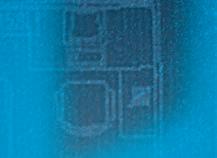






























BUILD WITH CONFIDENCE BUILD FASTER. SAVE MONEY. AUSREO.COM.AU ats@ausreo.com.au Sydney: (02) 9765 2100 Melbourne: (03) 9313 2700 YOUR ONE STOP SHOP FOR REBAR MODELING, PRODUCTION AND DELIVERY.
Interchange Vent Stacks Identify rebar cost savings in early design phase Build custom 5D rebar model to share with delivery partners Manufacture prefabricated elements to accelerate construction Deliver rebar to site with marking plans and schedules 01 02 03 04
Rozelle
COMMUNITIES FUTUREPROOFING
AN INSIGHT INTO THE SAMI BITUMEN TECHNOLOGIES’ ETHOS FOR COMMUNITY SUPPORT AND SUSTAINABILITY. AS SEBASTIEN CHATARD – GENERAL MANAGER AND DR. HAMIDREZA SAHEBZAMANI – TECHNICAL SERVICES MANAGER WRITE.
“Sustainability” is a multifaceted concept reflecting our collective aspiration for leading a healthy and happy life while preserving the health of our planet for future generations. The United Nations’ Brundtland Report in 1987 articulated sustainability as the ability to meet present needs without compromising future generations’ ability to meet their own needs.
In the scope of business, achieving sustainability leads to going beyond standard and regulatory requirements and innovating to support people without detriment to the environment.
Sustainability includes three primary dimensions: human, environmental, and economic, often referred to as the “triple bottom line.” While all three aspects should be considered, based on the situation, one may prioritise others. This necessitates decisionmakers to weigh the dimensions and set clear goals and strategies that reflect their organisation’s values and priorities.
The ultimate objective is to create a sustainable society where people thrive on a healthy planet, however, to fully achieve this, we need to shift our perspective and resolve things with a fresh mindset.
A sustainable society ensures that nature is not subjected to increasing concentrations of substances from the earth’s crust (e.g., fossil oil) or those produced by society (e.g., antibiotics).
Additionally, it refrains from causing physical degradation to the environment (e.g., deforestation) while eliminating structural obstacles to people’s health, influence, competence, impartiality, and meaning.
SUSTAINABILITY IN BUSINESS
Sustainability should not be treated as an addon feature but rather as the highest-level goal for an organization or project. It starts with a sustainable business strategy that ensures the long-term viability of the business. Elevating the value of human and environmental health, and considering long-term impacts, costs, and


benefits are integral to sustainability.
Organisations may embrace sustainability for various reasons, such as fulfilling moral obligations to humanity and the planet, complying with project requirements, or seizing business opportunities. Sustainability, when integrated into corporate culture and management practices, becomes an essential driver for success, enabling companies to align their actions with their values.
Context is crucial in sustainability, and priorities may vary depending on the business or project type. Therefore, sustainability approaches need to be tailored to the specific circumstances. The pursuit of sustainability also implies continuous improvement, with the goal of going beyond merely reducing harm to actively improving society and the environment.
In the industry, sustainability can be seen as a social responsibility, giving back to the community. It can also be a project requirement specified by an owner through contracts or specifications. As a business opportunity, sustainability can also lead to increased revenue, reduced costs, improved employee productivity, and minimised risks. Embracing sustainability aligns a business with its stakeholders’ long-term interests.
Many successful companies invest significantly in sustainability, and evidence suggests that businesses addressing sustainability tend to be more successful and profitable in the long run. In a 2011 paper, three researchers from Harvard Business School (Eccles, Ioannou, & Serafeim) defined “Low Sustainability” firms as those that primarily address social and environmental issues by adhering to regulations, while they classified “High Sustainability” firms as those that go beyond regulatory requirements in addressing such issues.
The study revealed that “high sustainability” firms outperformed “low sustainability” ones in terms of both stock market and accounting measures, but this advantage was observed only in the long run. Consequently, sustainability proves to be a beneficial factor, but businesses and investors need to exhibit patience and adopt a long-term perspective to fully reap its rewards.
When considering sustainability, diversity and inclusion might not be the first aspects that come to mind. However, these elements play a significant role in multicultural initiatives aimed at safeguarding the environment. More than mere programs or policies, diversity and inclusion serve as stabilising agents and
roadsonline.com.au 39 ENVIRONMENT & SUSTAINABILITY
Image: SAMI.
Using renewable energies is part of SAMI Bitumen Technologies’ sustainability strategies to reduce the carbon footprint of the company’s Laverton facility in Victoria.
practical tools that integrate culture into global development processes. Organisations that prioritize diversity and inclusion recognise that these are indispensable pathways to achieving a genuinely sustainable future.
Integrating diversity into sustainability entails recognising and valuing the strength in diverse voices. The broader the range of stakeholders involved, the more robust the outcomes become.
Collaboration is enriched by diverse opinions and approaches, leading to more comprehensive and innovative solutions. Moreover, when sustainable actions consider diverse communities, the benefits they yield are more equitably enjoyed by all the impacted groups.
One of the aspects of inclusion is achieving gender balance in businesses. Official statistics show that only 13 per cent of the construction industry comprises women, with only 30 per cent of them engaged in operational tasks.
The situation worsens when considering the very recent working paper from the Australian government’s treasury, published in March 2023, which highlights the income gap between males and females after the arrival of a child, commonly referred to as the “motherhood penalty”.
These numbers indicate that Australia still has a long way to go in achieving sustainability in certain aspects.
IT’S IN THE PAVEMENT
Similar to other construction sectors, road construction relies on various resources, some of which are non-renewable and require energy for extraction. This process releases greenhouse gases and poses environmental risks.
To address these sustainability challenges, the pavement industry is exploring innovative approaches.
One involves producing environmentally friendly products that maintain or improve engineering performance, striking a balance between sustainability and functionality.
Another strategy is creating highperformance materials that increase road lifespan and reduce maintenance cycles, withstanding road surface stresses for longerlasting pavements.
These alternative approaches strive to achieve sustainable solutions that minimise environmental impacts while maintaining road performance and safety.
The pavement industry actively pursues material reduction, reusing, and recycling strategies.
Reduction efforts aim to minimise the carbon footprint by developing bio-based alternatives with comparable performance. Lowering production temperatures with advanced technologies also contributes to environmental sustainability. By producing high-performance, long-lasting products, the industry optimises thickness, maintenance cycles, and overall road longevity.
Emphasising material reuse within its own operations, the industry focuses on careful engineering to maintain pavement functionality and performance. This includes designing new products and formulations that facilitate the reuse strategy. Asphalt is 100 per cent recyclable and is the most recycled material in the US.
By implementing these strategies, the pavement industry aims to minimise its environmental impact, conserve resources, and contribute to a more sustainable and circular economy.
THE
AUSTRALIAN PAVEMENT INDUSTRY
Australian pavement regulations and standard specifications need proactive integration of sustainability criteria for material production and project implementations. Several European countries have already adopted sustainability requirements in their design
“INTEGRATING
is another vital aspect of SAMI’s commitment to sustainable development. Collaborating with partners, sharing best practices, and actively participating in initiatives that drive social and economic progress are all part of SAMI’s sharing mindset.
Embracing a daring mindset, SAMI encourages innovation and forward-thinking while taking calculated risks. The company aims to lead by example and pioneer innovative solutions in the road construction and maintenance sector.
Environmental aspect, in line with its parent company Colas, the world leader in road construction and maintenance, SAMI has set ambitious carbon footprint reduction targets: a 30 per cent reduction by 2030 (scope 1, 2 &3 compared to 2019) and be carbon neutral by 2050.
In terms of innovative solutions, SAMI’s sustainable initiatives include the SAMIGreen range, which uses biogenic materials and biobased additives to reduce carbon emissions in asphalt.
The Crumbflex product incorporates crumb rubber from end-of-life tyres as a partial substitution for imported elastomeric polymers, reducing the carbon footprint while maintaining engineering properties. SAMIBioPrime, a carbon-neutral bio-based
DIVERSITY INTO SUSTAINABILITY ENTAILS RECOGNISING AND VALUING THE STRENGTH IN DIVERSE VOICES. THE BROADER THE RANGE OF STAKEHOLDERS INVOLVED, THE MORE ROBUST THE OUTCOMES BECOME.”
procedures and RFQ documentation.
Elimination of using cutbacks is a major action. To keep pace with global initiatives, we should swiftly re-evaluate our regulations and introduce obligations and incentives for the industry to adopt more sustainable road design and construction practices.
SAMI’S SUSTAINABILITY
Sustainability is a core value at SAMI, extending beyond environmental concerns to encompass various aspects of corporate social responsibility, with a strong emphasis on safety. SAMI’s foundation lies in its people, and its values of caring, sharing, and daring mirror those of its parent company.
Caring is at the heart of SAMI’s approach, ensuring the well-being of its employees, stakeholders, and the communities it operates in. The company fosters a safe and inclusive work environment and engages in responsible business practices that benefit society. Sharing knowledge, resources, and expertise
emulsion primer derived from renewable resources, replaces petroleum-based primers, further decreasing carbon emissions. Encouraging the use of bitumen emulsion, produced and applied at lower temperatures, also aligns with SAMI’s sustainability goals. By actively promoting these sustainable practices and products, SAMI Bitumen Technologies opens the way in reducing the carbon footprint of the pavement industry, contributing to resource conservation, recycling, and the adoption of ecofriendly alternatives.
References
Robert G. Eccles, Ioannis Ioannou, George Serafeim, The impact of corporate sustainability on organizational process and performance, Harvard Business School, 2011
Sustainable Asphalt Pavements: A Practical Guide Sustainability Overview, NAPA, 2019
Elif Bahar, Natasha Bradshaw, Nathan Deutscher, Maxine Montaigne, Children and the Gender Earnings Gap: Evidence for Australia, Australian Government the Treasury, March 2023
Holmberg, J. and Robèrt, Backcasting from non-overlapping sustainability principles – a framework for strategic planning, International Journal of Sustainable Development and World Ecology, 2000 https://www.ubqmaterials.com/blog-post/why-are-diversity-andinclusion-important-for-sustainability/
40 ROADS MAY 2024 ENVIRONMENT & SUSTAINABILITY

Achieve More with Less







Did you know that AI-powered mapping can reduce the time and cost of infrastructure projects by up to 30%


AI-enhanced mapping processes, streamline operations and lead to efficient project outcomes. aids in precise project project sustainability, guiding future-focused decisions.




Automation of tasks frees engineers for complex design, enhancing productivity.











hello@civiltechsolutions.com.au
92/8 Gardiner St, Darwin City NT 0800, Australia





Road civiltechsolutions.com.au

Contact
Assess
Worst
Us Let’s
Your


THWARTING THEFT
UNDERWRITING
AGENCIES OF AUSTRALIA (UAA) IS EDUCATING THE SECTOR ON RISK MITIGATION STRATEGIES TO HELP STAUNCH MACHINERY THEFT CLAIMS. ROADS & INFRASTRUCTURE SPEAKS WITH UAA’S MICHELLE MORRISSEY AND GEORGE GRASSO TO LEARN MORE.
An increase in plant and machinery theft sparked a renewed effort by Underwriting Agencies of Australia (UAA) to educate its clients and partners around the risk of theft, as well as some of the key strategies that could help to reduce said thefts.
UAA is working to highlight the importance of preventive measures for its current and prospective clients, ensuring that they can have protection, from both a security and policy perspective.
As part of this push, UAA engaged some independent external investigators to get a better read of the industry. As Michelle Morrissey, National Claims Manager, Australia – UAA explains.
“There is an increase in opportunistic thefts. A downturn in the industry, the economy itself and growing cost of living pressures can all play a part,” she says.
“Statistics found that in the 12 months ending 30 September 2021, that there were around 600 thefts that were reported to the police during that timeframe.”
With a median cost of $50,000 per unit, these thefts equated to a loss of around $21,000,000.
Additional data has reflected an increase in thefts claims across Queensland, Western Australia and New South Wales.
For motor vehicles, theft is also increasing in Victoria. There were 19,073 motor vehicle thefts recorded across Victoria in the year to September 2023, according to the Crime Statistics Agency. This represents an increase of 24.96 per cent (3798) from the previous year.
Despite this sharp increase, Morrissey says there’s still optimism around the sector. Educating the industry around the increase in theft claims, as well as potential risk mitigation
strategies has proven to be effective so far.
“It’s a risk to our clients ability to continue business operations,” she says. “More businesses are reaching out for risk mitigation strategies, not only for theft, but other types of damages as well, so they can reduce their exposure to potential loss.
“We’re seeing more of an increase in opportunistic thefts in the earthmoving space. That might be machinery on a site that’s close to a roadway, machinery that’s on a float trailer and easily accessible, even machines behind temporary security fencing where it’s quite easy to access the site.”
WHAT WORKS BEST?
As the mobile plant and equipment insurance specialists, UAA sees itself as an expert in its field. With 30 years of experience, the company aims to ensure that it can have an impact that goes beyond providing
42 ROADS MAY 2024
UAA is helping to reduce the rising number of thefts occurring across plant and machinery in the construction and earthmoving sectors.


industry-tailored products.
That’s part of the reason why it’s taken up a thought leadership position in the plant and equipment theft space.
“Having a machine registered halves the threat of theft. They’re more detectable by the police and much harder to sell,” she says. “Lodging machines on the PPSR (Personal Property Securities Register) is another strategy that makes it harder for machinery to be sold on. Machinery can be quickly identified if they’ve been flagged as stolen.
“Many of our clients are dry hire entities, who are more highly exposed to theft. It’s important to research and verify the company you’re hiring these units to. Ensure they have an established reputation before delivering a machine. The greatest risk for theft is during the weekend and long weekends when machines are left unattended for long hours.”
Morrissey adds that painting machinery in company colours and including logos can also make a difference when it comes identifying stolen kit.
“Branding and logos on machinery make these units much more identifiable. Making machinery as distinct as possible is important. Plain yellow machinery, for example, is likely to be targeted the most. Branding and distinct colours helps to make the machine less desirable,” she says.
“The more branding on the machine, the greater the reduction of theft. You might not be able to have CCTV or a person on site constantly. In order to provide some mitigation, applying branding can at least reduce some level of exposure to theft.”
Increasing the difficulty of access to machinery is a key step. Placement is another. Placement of the machine behind large scale objects on site can help to reduce the risk of opportunistic theft. This could be large machinery or attachments that are difficult to move around the machine.
Another interesting strategy is the use of what Morrissey refers to as a GPS decoy. GPS units are usually stripped during an incident of theft. Therefore, a decoy unit ensures that the machine can still be tracked to pinpoint the location of the machine after a theft has occurred.
This also applies to eliminating the ‘common key approach’, ensuring that speciality keys are required for each individual machine.
George Grasso, UAA Group Chief Claims and Service Officer, says understanding the thought process of the potential thief is also an effective approach.

“Put yourself in the thief’s shoes as much as you can. Start thinking about what would deter them bests from stealing your equipment. That’s the type of advice that we’re providing the industry around mitigating that loss,” he says.
“That bit more effort and a little more investment into this space can certainly save you a lot of pain down the road.”
Grasso says greater industry involvement will only help to stamp down on these incidents.
“I’d love to see the industry bound together and become a bit more unified around sharing ideas and helping to mitigate this loss,” he says. “I’d like to see a greater emphasis from the police in these cases as well, which are potentially under-resourced at the moment.
“Just the broader awareness around the industry and creating a greater level of diligence and vigilance, that’s what I’d like to see the most.”
In case these risk mitigation strategies prove not to be effective, UAA is there to assist. First by utilising the assistance of independent external investigators who correspond with the police and affected party. As Morrissey explains.
“They’ll obtain police reports as well as any information from the insured,” she says. “They’ll also look into any suspicious activity,

together to potentially find a suspect in the matter and determine how the theft was perpetrated. If they can access the GPS data as well, they can try and find the location of the machine.”
This information is not only helpful in solving the case at hand, but may assist to reduce the circumstances that gave rise to the theft in the future.
“If we can provide as much information as possible to the insured party, they can utilise migration strategies to prevent a similar event occurring in the future,” Morrissey says.
“It’s very important to be as vigilant as possible, particularly when there’s greater pressures around costs of living as well. We help our clients to answer two very important questions, ‘how did this happen? ‘And how can I stop it from happening in the future?’
roadsonline.com.au 43 INSURANCE
Image: stock.adobe.com/Roman_23203.
Michelle Morrissey, National Claims Manager, Australia – UAA.
AN ENHANCED SOLUTION

Trout River Live Bottom units deliver an enhanced solution for bulk transport applications, providing a safer, more versatile alternative to conventional tipping. Proudly manufactured locally in Australia, Trout River has built its reputation on providing quality tailored solutions backed with an unmatched national service and support network. Experience the Trout River difference and contact your local dealer today.

maxitrans.com/trout-river
DISCOVER MORE
SAFETY ON THE FRONT FOOT FOR
WIRTGEN HAS PARTNERED WITH STRATA WORLDWIDE TO INSTALL COMPATIBLE COLLISION AVOIDANCE TECHNOLOGY, HELPING TO IMPROVE THE SAFETY OF HAMM AG ROLLERS. HERE’S HOW THEY DID IT.
While improvements in technology, personnel protective equipment and processes have helped to move the needle when it comes to worksite safety, the industry as a whole continues to see incidents arise.
According to Better Health Victoria, 2023 saw 196 Australian lose their lives in work-related incidents. Just under a quarter of these deaths were related to the construction sector (22 per cent).
Machinery safety plays a key role in reducing this figure. That’s why roller manufacturer and distributor HAMM AG, part of the Wirtgen Group, has looked outside of the box to optimise the safety of operators and passers-by alike.
Craig Yeats, Product Support Manager – HAMM, says safety has always been an important consideration for Wirtgen, but recently there’s been a greater emphasis placed on optimising the safety capabilities of the company’s machinery.
Wirtgen Group machinery, including its HAMM AG range of rollers, are well known for their technological advances. To back up its commitment to safety, as well as to continue expanding the variety of software and hardware on each model, Wirtgen began looking at proximity detection systems.
“With every incident that happens on the worksite, safety gets highlighted more and more,” Yeats says. “We’re now owned by John Deere and safety is extremely high on
their priority list. It’s absolutely paramount and that aligns really well with the way that we work and run things as well.”
“All the different manufacturers and contractors think about safety in broad terms. For the implementation of new technology, different OEMs are doing different things. We know that some are using passive methods to improve safety.”
Wirtgen’s foray into proximity detection systems centred around achieving ISO certification (International Organisation for Standardisation) for its eventual device and machinery setup.
“Customers regularly asked about proximity detection that would include a degree of machine control. To incorporate more than just a warning system, HAMM AG decided to go down the ISO path,” Yeats says. “There’s an ISO standard for proximity detection systems that are integrated into construction equipment. As far as I’m aware, HAMM is the only roller OEM in the road construction space going down that path.”
The journey towards developing or implementing a detection warning system was initially sparked through a client request.
“Strata was approached by one of our customers to fit a proximity detection system on one of our rollers, that would control the machine and pull it up if a person
or object was detected. That rang alarm bells for us, as we were cautious of handing the machine control over to an external third party,” Yeats says.

This led Wirtgen to having a conversation with Strata Worldwide, which is responsible for the development of proximity detection systems and collision avoidance systems. These systems aim to prevent machine-tomachine collisions, as well as machine-toperson incidents.
Phil Jones, Global Product Manager SafeSITE AI – Strata Worldwide, says safety is a foundation for the development of the product, which now serves many industries, including general construction and mining.
“Firstly, we aim to pull someone who might be at risk, out of a dangerous situation. We can provide that through our hardware, like alarms, bright spots and other visual and audio warnings,” Jones says.
“The other aspect is behavioural change, aiming to get lasting results. If there’s an incident, we can take information from the danger zone, pull that apart and provide the customer with real time alerts. We can provide that data to management teams in a way that they can understand how to make sure these incidents don’t happen again.”
Yeats says, that in some ways, proximity detection systems are exactly what the
roadsonline.com.au 45 MACHINERY & EQUIPMENT
Safety is a major priority for HAMM AG, Wirtgen and other companies that fall under the John Deere Group.
Images: Wirtgen.

Stata Worldwide’s collision avoidance technology can be attached to a number of locations and machinery types.
industry has needed.
“Customers had been searching for machine control solutions to try and stop contact between machinery and personnel for years,” he says.
FIRST TRIALS
The first installation of Strata Worldwide’s systems did come with its challenges. It also marked the beginning of what has turned out to be an ever-growing relationship between Strata and Wirtgen.
“The very first implementation of a proximity detection system on a Hamm roller was in Adelaide in 2017, where we worked through some minor issues and had plenty of learnings. At first it was complicated to combine the operating system of the machine with the interface of the proximity detection system,” Yeats says.
“We couldn’t implement the system into the drive control because we simply didn’t have the interface, software, or anything developed at that stage. But the conversation never stopped between both of us.”
From initial trials, Wirtgen/HAMM AG worked with Strata to develop a system that could be applied across the majority of roller models. This process represented a learning experience for both companies.
“Essentially, the technology that Strata developed uses AI to identify objects or people on the worksite. Strata was able to work with a partner to develop the interface to take the analogue language from the
system, or digital language, and convert it to the language of the machine, which was the ISO standard,” Yeats says.
“I believe the first implementation was in 2020, during COVID. The first systems were put onto a machine for testing in our yard. There’s been a lot of testing in controlled situations since.
“Almost from day one, it worked really well. There were little tweaks here and there, but long story short, it’s taken several years of trial and error but now we have a system out there that’s doing exactly what the customer requires.”
Hamm AG is now one of the first to manufacture compaction equipment with ISO compliance in this specific area.
Satisfying the ISO standard has also opened the door for HAMM AG’s customers to use a combination of different technologies, with many now compatible.
Adopting the ISO standard for the integration of these systems allows the operator or fleet manager to select a proximity detection system of their choosing (that’s also ISO compatible) for use on HAMM AG rollers. Yeats explains.
“It just means that there’s common ground,” he says. “There’s no reinventing the wheel, every time a different supplier wants to put their system into one of our machines, you’ve got a standard interface. At that point, it doesn’t matter who the supplier is.”
Strata’s technology is also highly adaptable depending on the type and make of machinery.
Jones says a key difference between Strata’s products and others is the satisfaction of level nine EMESRT (Earth Moving Equipment Safety Round Table) requirements. These requirements outline the standard required and dictate the application and installation for the use of proximity detection systems.
Strata’s installations on Wirtgen/HAMM AG equipment satisfies level seven and nine requirements. The former includes audible and visual alarms to enhance operator awareness. The latter revolves around the automatic intervention of the system, therefore allowing it to override the equipment’s movement to prevent nearby collisions with either machinery or people.
Customer requirements are the greatest determinator of whether a level seven or nine system should be installed, with factors such as the age and type of machine dictating this direction.
In order to ensure the correct system is selected based on the information at hand,
Strata undertakes a thorough process to evaluate the most complementary option, as Jones explains.
“With Wirtgen we undertook what we call a discovery phase. That’s where we actually work out how we can interface with the machine. It’s not as simple as taking our interface to the machine and plugging it into the data port,” he says.
“We design the interface, we risk assess it, then we set about implementing it. We put the interface in, we do the firmware modifications and then confer with the customer.”
In the end, Jones, Yeats, Wirtgen/HAMM AG and Strata are all united in one key aspect. Safety, above all else.
“The main thing I want to see is proven deployments. Scenarios where we can see that our technologies have helped to save a life,” Jones says. “We want to make sure that people can go home at the end of the day in one piece. A lot of people in the industry have been affected by or know someone who has died in these accidents.
“That’s why companies like Wirtgen want to see their product out there with the safest solution that they can apply. There’s been learnings along the way, but it’s been great.”
Yeats says the continual push for safer and more efficient machinery will never stop, and while there’s a lot more work to do, technologies such as these are pointing manufactures in the right direction.
“We all want to do as much as possible to eliminate that risk, whether that be via machine controls, or people having different choices about how they want to go about it. One of the best things about the Strata system is that it focusses firstly on people, not necessarily plant, cones or pieces of the road itself,” he says.
“Strata have been absolutely sensational. There’s been a few moving parts and some key learnings, but we’re both very excited to have this rolled out. We’re really pushing this and working well together to help each other out. But the work’s not done yet.
“That means no shortcuts. Where safety is concerned, you just can’t play that game.”
Wirtgen/HAMM AG and Strata are constantly working to update and enhance both the software and hardware components of these systems.
“It’ll continue to evolve. But as of right now, its raring and ready to go,” Yeats says. “It’s extremely promising and we can’t wait for more people to learn about these systems.”

46 ROADS MAY 2024 MACHINERY & EQUIPMENT

Bentley Illuminate Infrastructure Engineering
Conference
Sydney 2024 | Thursday,
23 May 2024
The time is now to uncover the transformative power of data-driven decision-making to fortify infrastructure and adopt sustainable practices, improving outcomes and enhancing community well-being across Australia and New Zealand.
Hear from industry leaders about the latest in infrastructure intelligence, sustainable digital delivery, and infrastructure resilience.
Connect with peers and forge meaningful connections.
Discover strategies to enhance outcomes and mitigate risks.
To register, visit bentley.com/illuminate2024 or scan the QR code:
IN PARTNERSHIP WITH
JOHN DEERE’S NEXT PHASE
JOHN DEERE INTRODUCES ITS 950 P-TIER AND 1050 P-TIER LARGE DOZER MODELS, WHICH HAVE ADVANCED VISIBILITY AND SAFETY FEATURES AS PART OF THE TRANSITION TO P-TIER. ROADS & INFRASTRUCTURE SPEAKS WITH THE JOHN DEERE TEAM TO LEARN MORE.

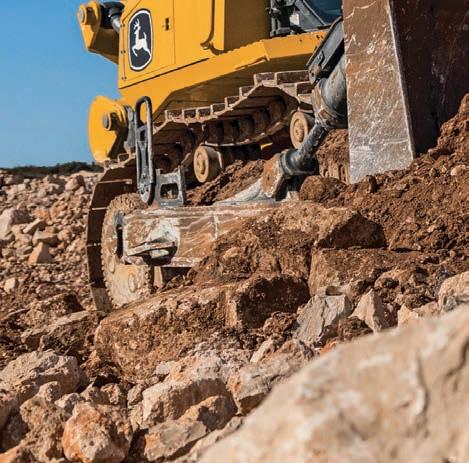
Improving its product portfolio of large dozer offerings, John Deere introduces the 950 P-Tier and 1050 P-Tier dozers as part of its performance tiering strategy. Previously in market as the 950K and 1050K, these robust machines are the next generation of models to join the increasing lineup of John Deere P-Tier dozers.
The new 1050 P-Tier dozer boasts an increase in engine power and a redesigned hood and front-end design. In addition, both the 950 P-Tier and 1050 P-Tier offer enhanced visibility and improved safety features, positioning them as an ideal solution for operators aiming to boost productivity and protection on the jobsite.
Matt Costello, Product Marketing Manager, John Deere Construction & Forestry, says the 950 P-Tier and 1050
P-Tier dozer models were updated with the customer in mind, helping them increase efficiency, visibility, and gradeability in even the most demanding conditions.
“John Deere is dedicated to providing its customers with large dozer options that fit the needs of every job site, and the new P-Tier machines offer the durability and reliability our customers demand from machines of this size class,” Costello says.
The strategic design enhancements of the new P-Tier dozer models aim to improve operator safety, visibility on the job, and uptime. Now equipped with standard LEDs, operator efficiency has been significantly improved during nighttime or low-light operations. Also helping to improve uptime, the cold weather hydraulic lines are specially tailored for cold climate operations.

These hoses, which replace the standard option, are rated for lower temperatures, ensuring smooth hydraulic function in harsh winter and weather conditions. The cab of the 950 P-Tier



48 ROADS MAY 2024
John Deere has introduced its 950 and 1050 P-Tier large dozer models.
Images: John Deere.

and 1050 P-Tier can be tilted for easy serviceability access under the cab.
COMFORT AND SAFETY
Taking safety to the next level, the Operator Presence System ensures that an operator is present in the seat of the cab, with the seat belt fastened, before the park brake can be released. This ensures a critical layer of safety, preventing accidental movement or operation before the operator is buckled in.
The P-Tier system also integrates the park brake switch into the system status monitor, eliminating the need for traditional park lock levers. This integration not only streamlines the operation process but also enhances the overall safety mechanism of the machine.
Enhancing operator comfort and functionality, both models now feature a premium heated and ventilated seat option, which is air-suspended with adjustment controls for optimal ergonomics. The seat design remains at a 15-degree angle to provide optimal comfort when operating the rear ripper.
The updated cab features new ergonomic controls, neutral counter rotate, and an integrated forward neutral reverse switch. This ergonomic focus ensures operators can work for extended periods with reduced physical strain, helping to
enhance productivity on the job site.
Remaining the largest Power-AngleTilt (PAT) dozer in the market, the 950 P-Tier dozer features SmartGrade™, John Deere factory integrated mastless 3D grade control. This machine has the power for heavy cuts and the finesse to finish grade.
Receiving a significant increase in operational advantages upon its entry to the P-Tier portfolio, the newly upgraded 1050 P-Tier dozer boasts a range of features and enhancements that boost overall functionality and efficiency. One notable upgrade is the tag link and blade
design that brings the blade 10 inches (25.4 centimetres) closer to the frame. Along with the tag link, inverted tilt and pitch cylinders were added.
The inverted tilt and pitch cylinders, lowered hood and larger front window help improve operator visibility to the blade. The repositioning of the 168inch (427-centimetre) blade, due to the updated tag link design, paired with double-bogie undercarriage provides operators with a more balanced machine and a clearer view of the blade corners, which is a critical factor for precision work.
In terms of power, the 1050 P-Tier dozer features a revamped JD14 (13.6 L) engine which replaces the 13.5 L engine in the 1050K. The JD14 enhances durability, reduces fuel consumption, and uses a single canister in the after-treatment system to meet emission regulations without the need for a diesel particulate filter. Lastly, on the 1050 P-Tier, the new cooling system has been redesigned with a single plane layout, positioning coolers side-by-side instead of stacked. This new design not only improves cooling efficiency but also simplifies access for cleaning.
To learn more about the latest P-Tier dozers, as well as the full lineup of John Deere machines, contact your local John Deere dealer or visit https:// www deere.com.
“THE INVERTED TILT AND PITCH CYLINDERS, LOWERED HOOD AND LARGER FRONT WINDOW HELP IMPROVE OPERATOR VISIBILITY TO THE BLADE.”

roadsonline.com.au 49 MACHINERY & EQUIPMENT
The cab of the 950 P-Tier and 1050 P-Tier can be tilted for easy serviceability access under the cab.
Both models now feature an updated cab that has new ergonomic controls, neutral counter rotate, and an integrated forward neutral reverse switch.



Compliance monitoring and reporting?
We have you covered.
We scale to all sizes of projects with no hardware, or hardware combined options. All within a leading technology platform - reducing the hassle, increasing reliability:

Set up in as little as 10 minutes.
Monitor live conditions against project KPIs.
Easy reporting against baselines and project scorecards.









Quickly adjust monitoring without the need for site visits.












Mooven is a AI-powered platform designed to accelerate infrastructure delivery, transform efficiency and reduce complaints.






www.mooven.com
Queue monitoring Dynamic Travel Advice to VMS Proactive alerts No hardware required Set up in minutes

END OF THE
POTHOLE PIT?
THE BANE OF MANY COUNCILS IS THE EXISTENCE OF POTHOLES IN ITS ROADS. REPAIRING THEM TAKES TIME AND MONEY, BUT ONE NEW MACHINE MAKES THAT JOB SIGNIFICANTLY EASIER.
Potholes have become a significant headache for Australian drivers and a costly burden for the roading and infrastructure industry. According to the Australian Flexible Pavement Association, recent estimates suggest repairs could cost a staggering $4 billion across the country every year.
These road craters damage vehicles and contribute to road safety concerns, particularly in regional areas.
Not only that, rural and regional areas tend to be overrepresented in the impact of accidents, and potholes form part of that problem. According to the Bureau of Infrastructure and Transport Research Economics (BITRE), 1193 people died on Australian roads in 2022, a five per cent increase compared to the number of motorists killed in 2021.
Of the 1193 reported deaths on Australian roads in 2022, 776 people were killed in regional areas – accounting for 65 per cent of the overall figure – while 417 lost their lives in
metropolitan areas.
A BITRE study found the poor quality of roads in regional areas is directly linked to the rising road toll in rural and remote locations. This includes poor design, repair flaws, inadequate safety treatments, and insufficient infrastructure for vulnerable road users.
It’s critical that councils, who are ultimately the managers of roads in much of Australia, can take quick action to repair potholes. What new technology can support these goals?
JCB POTHOLE PRO

The JCB Pothole Pro is a unique three-in-one solution specifically designed to permanently fix any pothole repair or large patching operations efficiently and economically. It comes with three dedicated attachments to cut, crop, and clean.
The three-in-one approach dramatically reduces the costs of permanently repairing a pothole by about 50 per cent. This sum includes material, labour and capital costs. Users can also recycle the planning materials as the base or remix them to be used as new asphalt.
As such, there is no need for additional specialist equipment or extra manpower, which can help councils save both time and money. With a typical pothole repaired
roadsonline.com.au 51 MACHINERY & EQUIPMENT
Images: JCB CEA
JCB CEA views the Pothole Pro as a true gamechanger for the industry, with its suitability for use nationwide.
A small footprint means that roads can continue to operate with minimal disruption.

in eight minutes, why compromise on a quick fix that won’t last when a quick and permanent fix is available? All that is needed is tar.
SAFE AND ECONOMICAL
The JCB Pothole Pro eliminates the need for jackhammers or circular saws, which can also reduce the risk of Hand-Arm Vibration Syndrome (HAVS). This syndrome is derived from vibrations transmitted to the hand and arm when using specific tools. The central cab provides excellent



360-degree visibility. That ensures the driver can see the public, increasing safety during operations. It’s also designed to reduce the amount of time operators spend repairing the road while it is being driven on.
There’s also no need for a sweeper on site, as the 1200-millimetre built-in sweeper collector allows operators to prepare the pothole in just minutes.
From the convenience of the cab, users can adjust the 600-millimetre planer. It offers hydraulic depth and tilt control, further improving safety. The dedicated cropping tool provides a uniform hole profile for permanent pothole repair.
By utilising a JCB Pothole Pro, operators can take advantage of JCB LiveLink, which helps users to achieve increased uptime and monitor metrics like fuel efficiency. JCB LiveLink can also help organisations protect their assets by using geofencing.
INCREASED PRODUCTIVITY
With a single pothole being repaired in eight minutes, local councils can fill over 700 potholes every month. This comes from preparing 250 square metres of road in one



shift, equating to over 5000 square metres per month.
That efficiency means that less time is spent on truck rollouts and more time is spent on repairing potholes. The JCB Pothole Pro is driven directly to the site without any need for additional transport.
JCB CEA has an extensive network of dealers across Australia. With a strong focus on maximising machine uptime. The business also places great importance on aftersales support and providing a highly skilled technical team to assist customers with their ongoing equipment needs.
This machine is a fantastic addition to any local council’s infrastructure set. There are always ways to use the JCB Pothole Pro beyond its traditional pothole-repair process. With the wide range of attachments available from JCB, it can carry up to one tonne in a shovel, stump grind, mow grass, trim hedges and trees, move pallets, blow snow and do trenching and demolition work.
Such flexibility gives local councils increased flexibility and productivity in an environment where the focus is on maximising asset use.





































MACHINERY & EQUIPMENT
The Pothole Pro from JCB CEA provides flexibility in its functionality.
AGRICULTURE FARMING EDUCATION WASTE
MANAGEMENT RESOURCEMANAGEMENT
CONSERVATION MANUFACTURING RESOURCES
ENERGY HEALTH & SAFETY INFRASTRUCTURE
ENGINEERING MINING CONSTRUCTION
QUARRYING AGRICULTURE FARMING EDUCATION
WASTEMANAGEMENT RESOURCEMANAGEMENT
CONSERVATION MANUFACTURING RESOURCES
ENERGY HEALTH & SAFETY INFRASTRUCTURE
ENGINEERING MINING CONSTRUCTION
QUARRYING AGRICULTURE FARMING EDUCATION
WASTEMANAGEMENT RESOURCEMANAGEMENT
CONSERVATION MANUFACTURING RESOURCES
ENERGY HEALTH & SAFETY INFRASTRUCTURE
ENGINEERING MINING CONSTRUCTION
QUARRYING AGRICULTURE FARMING EDUCATION









WASTEMANAGEMENT RESOURCEMANAGEMENT MANAGEMENT

SEARCH FOR TOP INDUSTRY TALENT THROUGH OUR JOBS BOARD. CONNECT WITH ALIGNED CANDIDATES.
BOOST YOUR CHANCES OF FINDING SKILLED APPLICANTS.
SCAN TO CREATE AN ACCOUNT TODAY AND DISCOVER YOUR PERFECT MATCH!
TRAILERS ABOUND
AVIJOHN CONTRACTING HAS BEEN LAYING ASPHALT ON ROADS ACROSS THE SYDNEY METROPOLITAN AREA FOR MORE THAN 30 YEARS. THE COMPANY RECENTLY UPGRADED ITS FLEET TO INCLUDE A NEW TROUT RIVER LIVE BOTTOM TRAILER.
Avijohn Contracting is a familyowned company that has been in business for over 34 years. It began as a civil contracting company in the Sydney metropolitan area, predominantly constructing car parks, driveways, playing fields, and the like.
In the last 15 years, Avijohn has evolved and concentrated on training and honing its expertise in asphalt paving.
Michael Kennedy is the Operations Manager at Avijohn Consulting. His parents started the business all those years ago.
“These days, we mostly do asphalt work for local government and private contractors,” says Kennedy. “We also do a lot of profiling work, ripping up roads and material recycling.”
Avijohn has invested in plant and equipment designed to meet the specific requirements of asphalt paving work. Its management and crew are trained and experienced in providing high-quality outcomes for its customers.
Ongoing crew training and upgrading equipment and plant are essential parts of Avijohn’s operational philosophy to ensure its high standards are maintained.
UPGRADING EQUIPMENT
Avijohn has a significant fleet and recently purchased a Trout River trailer from their local MaxiTRANS dealer in Campbelltown. The trailer is a specialised live-bottom unit that offers operators an enhanced solution for bulk transport applications.
The capability to empty its content using an interior conveyor belt system offers operators a safer and more versatile alternative to conventional tipping and unloading in environments with low structures and overhead obstacles. It also practically eliminates the chance of the trailer tipping over. The tri-axle semi-trailer is perfect for what Kennedy and Avijohn handle.
Kennedy has found the Trout River Live Bottom Trailer an excellent acquisition.
“It’s been brilliant and very reliable,” he says. “Normally, I would expect trailers, asphalt, and profiling equipment to have minor issues
with them. It tends to occur when there are so many moving parts to some equipment. There’s an expectation for some small teething issues, but we have experienced very few.”
BENEFITS OF TROUT RIVER TRAILERS
Live-bottom trailers are unique because they have a conveyor belt at the bottom of the trailer tub. The belt is designed to push the material out of the back of the trailer at a controlled pace, so the trailer does not have to be raised to deposit the materials.
“One of the best parts of the Trout River Live Bottom trailer is that the conveyor belt is reversible,” Kennedy says. “That’s great if we don’t need all the material in the trailer. For example, if it’s the last load of the day, it is very helpful to be able to reverse the belt backwards. We can get the trailer back to a safely distributed weight.”
A unique feature of the trailer is the inclusion of weight scales for both the truck and the trailer. Keeping the maximum weight within the limits is vital for maintaining the machines and keeping them on the road.
“What is also good is the lower sides to the trailer,” Kennedy says. “That makes
loading and profiling much easier and more accessible. It also increases the speed of loading and unloading the trailer.”
It’s worth noting that live bottom trailers tend to be more stable. This minimises the risk of the trailer tipping over during the unloading process. Increasing safety in this manner is part of Avijohn’s approach to safety.
“It is just as important to us that our employees’ safety and workplace relations are always considered and maintained,” says Kennedy.
“We foster an environment focused on ensuring that all work is carried out harmoniously without interruption caused by industrial relations issues. A healthy, happy workplace assists us in achieving outstanding results for our company and customers.”
CUSTOMER SERVICE
What is often not discussed is the influence of high-quality customer and after-sales service from a seller.
“With MaxiTRANS, we’ve found that their team is fantastic at following up,” Kennedy says. “We have not had any major issues with the trailer, and with the one minor issue, the team fixed it within about four hours. We had it back on the road that night.”
When it comes to equipment from MaxiTRANS, Kennedy believes Avijohn made the right choice.
“The team at MaxiTRANS has been professional and more than helpful,” he says. “We are looking to purchase some more trailers in the next financial year, and there is a good chance we will choose some of their trailers.”


54 ROADS MAY 2024 MACHINERY & EQUIPMENT
Image: Maxitrans.
The Trout River trailer is a specialised live-bottom unit.



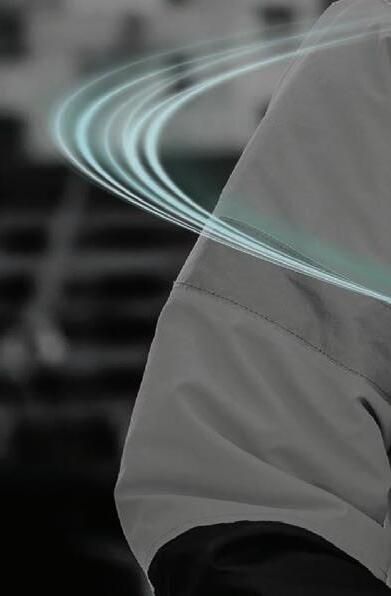




BEST
AUSTRALIAN
womeninindustry.com.au TICKETS ARE NOW ON SALE PROUDLY SUPPORTED BY Australia
PRESENTED BY MHD upply
JOIN US TO CELEBRATE THE BEST OF THE
FROM ACROSS THE
INDUSTRIALS SECTOR Celebrate the women who work tirelessly to advance the mining, engineering, road transport, logistics, rail, bulk handling, infrastructure and waste management industries. Thurs 20 June, 2024
PROUDLY
DIVERSITY PROGRAMS EVOLVING
THE CONSTRUCTION AND MINING INDUSTRY HAS ALWAYS BEEN MALE-DOMINATED, BUT GLOBAL EQUIPMENT MANUFACTURER KOMATSU IS WORKING TO CHANGE THAT.
Mel Morrison, General Manager of Human Resources at Komatsu Australia, says the Australian business has a three-year roadmap for inclusion and diversity.
“Komatsu believes that achieving greater diversity within industrial sectors has the power to be transformative. But we also acknowledge that there is a long way to go. There is work to do, and we are committed to doing it,” she says.
Key elements of the diversity strategy include advancing women in leadership, challenging stereotypes while embracing Komatsu’s richly diverse culture, promoting the wide range of careers the industry offers, and bridging the gender pay gap.
“With the Workplace Gender Equality Agency’s recent publication of gender pay gap reporting, the level of interest in this topic is very high,” Morrison says. “And it is a challenge of greater magnitude in our industry than in many others. There have been historically roadblocks to
attracting female talent.”
Part of that, she says, stretches back to the challenges of getting women into science, technology, engineering, and maths (STEM) careers.
“I think we are making headway in this regard,” Morrison says. “We are promoting STEM careers in universities and TAFEs, as well as at the grassroots level in schools. We spend significant time connecting with schools, as it helps us develop the connections early for our award-winning apprentice and graduate programs.”
Komatsu has aspirations of increasing the proportion of women for entry-level recruitment to 30-50 per cent. However, attracting female applicants for trade apprenticeships has required a sustained focus. This year, over 40 per cent of Komatsu’s apprenticeship applications were from women, and the 2024 apprenticeship cohort is represented by over 40 per cent females.
MAKING THE WORKPLACE FAMILY-FRIENDLY

Supporting parents and families in the workplace is another critical element in promoting inclusion and diversity.
“We have been focusing heavily on ensuring we provide an environment for people of all genders and backgrounds to have a thriving career,” Morrison says. “For example, we’ve recently introduced Families at Komatsu, a family-friendly policy that supports both women and men in balancing work and family commitments.
“We’ve increased our paid parental leave to 16 weeks for primary carers and four weeks for secondary carers. Even before the recent government announcement, we were already paying superannuation on top of our paid parental leave. It’s about helping our employees through their critical life milestones.”
CHAMPIONS OF CHANGE COALITION
Komatsu Australia’s CEO, Sean Taylor, is a member of the Champions of Change Coalition, a globally recognised, innovative

56 ROADS MAY 2024
Diversity programs are vital for attracting and retaining talent at Komatsu Australia.
Images: Komatsu Australia

Providing opportunities for women requires a solid commitment to workplace diversity and inclusion.
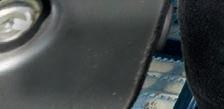
strategy for achieving gender equality, advancing women into leadership roles, and building respectful and inclusive workplaces.
The Coalition sees men in positions of influence commit to leadership and accountability for change on gender equality issues in their organisations and communities.
“Through Sean’s participation in this Coalition, he is signalling a very strong personal commitment to diversity, not only within our business, but across the broader industry in which we operate”, Morrison says.
CHALLENGING STEREOTYPES
Part of the evolution of Komatsu’s inclusion and diversity program is developing a culture where women can picture themselves in any role, from the workshop to the boardroom.
“We want to position ourselves to attract as diverse an application pool as possible,” Morrison says. “The business expects recruiters to provide a minimum number of female candidates for every role. Komatsu embraces diversity on its interview panels and in making selection decisions”.
“Through the recruitment pipeline, we work to find the best person for the role, so removing biases as part of the preinterview screening is key.”
That includes reconsidering the prerequisites for positions. Komatsu has recently redefined its criteria for positions to focus more on transferable skills and less on specific experiences, which opens up the candidate pool. Right now, 43 per cent of Komatsu’s senior leadership roles are held by women.
The business is actively assessing ways to drive greater pay equity and fostering an environment where everyday sexism is challenged through initiatives like the ‘Respect at Komatsu’ campaign.
THE FUTURE
Morrison says Komatsu recognises that every business is looking for the best talent, so it’s critical to create a culture and environment that is exciting, inclusive and provides real opportunity for a
“THROUGH THE RECRUITMENT PIPELINE, WE WORK TO FIND THE BEST PERSON FOR THE ROLE, SO REMOVING BIASES AS PART OF THE PRE-INTERVIEW SCREENING IS KEY.”
Komatsu also has a MyCareer program as part of its recently refreshed talent processes. This program is fundamental to managing employee performance and careers and articulates Komatsu’s approach to structured career development processes.
“Everyone has the opportunity to consider their career opportunities and pathways at Komatsu, and we support our employees in achieving these aspirations,” Morrison says.
diverse range of employees.
“We are competing for top talent. Many companies are trying to recruit women, particularly trade-qualified women. We have to walk our talk and demonstrate the huge range of experiences our industry offers, from innovative technology to foundational roles in building our society.
We then need to show that we can offer those opportunities in an environment that is inclusive, supportive and open to change.”
roadsonline.com.au 57 MACHINERY & EQUIPMENT





















MEGATRANS is Australia’s largest integrated conference and exhibition dedicated to the logistics industry. MEGATRANS is an interactive expo, reserved for companies o ering advanced technology technologies and services, grouped by their contributions to the sustainable supply chain. IN CONJUNCTION WITH ASSOCIATION PARTNERS PROUD SPONSOR FLEETS OF THE FUTURE THE ZERO CARBON WAREHOUSE COLD CHAIN SOLUTIONS THE TRACEABLE SUPPLY CHAIN Will you be a part of the supply chain of the future? BOOK YOUR STAND TODAY megatrans.com.au Melbourne Convention and Exhibition Centre 18-19 SEPTEMBER 2024 Don't miss out, secure a prime position
INTO TOWN ASPHALT ROYALTY ROLLING
TUTT BRYANT HAS SUPPLIED WORLD-CLASS COMPACTION TECHNOLOGY TO THE AUSTRALIAN MARKET SINCE 1986. WITH NEW DEVICES COMING ONLINE, THERE IS A NEW KING OF THE ROAD.
Having worked with Tutt Bryant Equipment for some 18 years, including the last nine as National Business Development Manager for exclusive brands BOMAG/Gehl/Lintec-Linnhoff, John Glossat is eager to always bring high-quality products to the market.
“As a company, we are excited about the opportunities that have arisen in partnership with all our original equipment manufacturers (OEMs). This is in addition to our internal and external reviews, which have created unique insights into the business and our key industries,” says Glossat.
Tutt Bryant is now ready to expand into the Road Asphalt and Infrastructure segment even further, being already a successful and well-known supplier of single and double drum rollers.
Glossat says, “Our TBE Team is working overtime to increase its parts holdings and service support to give the confidence to our end users to support their business efficiently and promptly.
“It’s worth noting that BOMAG has now established local, original equipment manufacturer (OEM) support systems,” he says. “That means we can quickly combat any issues that might arise in a collaborative partnership.”
ASPHALT INDUSTRY
The role of Tutt Bryant asphalt champions and advocates from every state has been critical for the development of the company’s corporate network across Australia. The champions recently returned to BOMAG headquarters for in-depth factory application training. The goal was to help the champions promote the new features through first-hand experience rather than just reading some brochures.
“Tutt Bryant understands that there is more to the relationship with our customers than merely signing on the dotted line,” Glossat says. “We want to be long-term partners

with our customers, and that comes from providing high-quality support.”
Tutt Bryant works with its overseas partners to bring innovative, world-class machines to its customers.
“We like to say that asphalt is running in our veins,” says Glossat. “Tutt Bryant recently signed an exclusive contract with Lintec Linnhoff to provide our customers with new ways to improve their asphalt plants. We can offer that support yearround and are a supplier that always strives to provide the best support possible.”
Glossat is particularly excited about the new machines coming into Australia, the first of which is the BOMAG BF 200 C-2.
“It is compact, strong, and reliable,” he says. “The small machines from BOMAG know their trade just as well as their big brothers. It’s perfect for narrow paths, next to walls or between buildings. This versatility makes the BF 200 C-2 compact paver a first-class tool.”
This compact paver has a minimum paving width of just 1.1 metres, making it ideal for tight spaces. It is also lighter and narrower than other pavers, so it fits on any truck.

“That’s fewer rollouts to get machines to a site, which is ultimately better for the environment,” Glossat says. “There’s no time wasted when relocating, which means it gets more use, more often.”
BF 300 P-2
The other compact device coming into Australia for the first time is the BF 300 P-2 city paver. It features a powerful yet economical 55 kilowatt (kW) engine that operates within ECOMODE engine management. ECOMODE saves up to 20 per cent fuel and emits far less noise.
“It also features the MAGMALIFE heating elements,” says Glossat.
“All the heating rods are cast into one aluminium block. The heat-up time is significantly shorter because of the metal’s excellent thermal conductivity, so the paver and team are ready for operation more quickly. It can cater for most general paving jobs, with a laying width of up to five metres.”
For more information, please visit tuttbryant.com.au or call 1300 658 888.
roadsonline.com.au 59 MACHINERY & EQUIPMENT
The BOMAG BF 200 C-2 track paver features a narrow 1118-mm track width.
Image: Tutt Bryant.
AFPA’S INTERNATIONAL WOMEN’S DAY
– BRISBANE, MELBOURNE, ADELAIDE, PERTH AND SYDNEY
The Australian Flexible Pavement Association is committed to fostering workforce diversity and inclusion and supporting workplaces that respect and value all people. In March 2024, AfPA held its inaugural multi-State International Women’s Day Industry event designed to inspire, acknowledge and engage women in the flexible pavement industry.
INTERNATIONAL WOMEN’S DAY
AfPA held breakfasts in Sydney, Melbourne, Brisbane, Perth, and Adelaide, representing the first multi-state International Women’s Day (IWD) event.
The event as attended by 430 people nationally, sought to celebrate the achievements of women across the industry. It also promoted gender diversity while increasing awareness and positive action to address barriers. Several opportunities were also identified to support women in the industry.
The event was aligned to the International Women’s Day 2024 theme of ‘Inspiring Inclusion’. The Keynote Speakers included Julie Mitchell (Deputy Director-General. Transport and Main Roads), Pamela Henderson (Head of Technical Services, Transport for NSW), Meredith Hammat MLA, Parliamentary Secretary to the Deputy Premier; Treasurer; Minister for Transport, Tourism and Parliamentary Secretary to the Minister for Education; Aboriginal Affairs; Citizenship and Multicultural Interests, Charmaine Higgins (Group Executive for People & Capability, Ventia) and Evonne Penrose (Trainee Safety Supervisor, BMD).
Together with Industry Panels in each State, these figures reflected on their career


women from across the flexible pavement industry, the broader building and construction sector, and beyond. This follows the publication of AfPA’s Diversity and Inclusion Roadmap in May 2023.
The Roadmap aims to promote inclusivity and address skills shortages across the flexible pavement industry. AfPA has consistently recognised the positive impact of an inclusive workforce on productivity, innovation, and capability, which in turn contributes to building a stronger industry to support roads and infrastructure. The AfPA Diversity and Inclusion Roadmap comprises of a number of initiatives being driven by the Association together with it’s members and the broader industry to strengthen and empower the industry. The initiatives represent a strategic and

AfPA attracted 430 attendees to the breakfasts at the Langham (Sydney), The Kew Golf Course (Victoria), Adelaide Convention Centre, and Frasers Restaurant (Perth). All five breakfasts sold out, with long waitlists for those hoping to attend.
Sponsors like Ventia, COLAS, Puma Energy Bitumen, Just Careers Training and Licences 4 Work ensured these breakfasts could go ahead.
The breakfasts were delicious, the discussions insightful, and it is clear that there is a significant demand for more of these breakfasts across a range of matters concerning Diversity and Inclusion in the future. AfPA is proud of its services to its members, and the IWD breakfasts show just how important members are to the organisation.

60 ROADS MAY 2024
Images: AfPA.
The Australian Flexible Pavement Association’s (AfPA) International Women’s Day breakfasts were held right across the country.
The Australian Flexible Pavement Association’s International Women’s Day breakfasts celebrated and highlighted women from across the sector, right across the country.

THE PRECAST INDUSTRY… A SUPPLIER’S TAKE
NATIONAL PRECAST’S CEO SARAH BACHMANN
GETS UP CLOSE WITH ONE OF THE ASSOCIATION’S MORE RECENT INDUSTRY PARTNERS, PSA. HERE, SHE CHATS WITH PSA’S MANAGING DIRECTOR, MICHAEL SMITH.
SB (Sarah Bachmann) – From your perspective, what are some innovations happening within the precast industry and how is your company contributing to those?
MS (Michael Smith) – The precast concrete industry has been witnessing numerous innovations over the last decade that are aimed at enhancing efficiency, sustainability and design flexibility. PSA has made significant contributions in all these areas through innovation and product development. Using recycled material to manufacture a range of plastic products that are used in precast is certainly a step towards sustainable practices to reduce environmental impact. We are also working on several other new innovative products that could revolutionise the precast industry in the coming years.
SB – What triggered your decision to become a National Precast Industry Partner?
MS – PSA became an Industry Partner in July 2023 after holding an Industry Supplier Membership for several months. As PSA’s market share has grown significantly in recent

Formliners create an enviable pattern in retaining wall panels for the Melton highway project.

years, we decided to contribute more to the precast concrete industry and we felt the best way to do that was as an Industry Partner. We believe PSA has much to offer the industry, with our diverse expertise in various aspects of supply and we will continue to contribute in every way we can.
SB – What do you consider to be the major challenges confronting the precast industry, and how do you propose to address them?
MS – While there are many challenges currently confronting the precast industry, supply chain disruptions would be at the top of my list. Global conflicts, natural disasters, and events such as the COVID-19 pandemic, have impacted the availability of raw materials, equipment and skilled labour for the precast industry. Interruptions in supply chains can lead to project delays, cost overruns, and uncertainty in the construction industry. PSA has been successful so far with overcoming these challenges by strategically planning to hold more stock of high demand items.
The effects of inflation on the industry has also been a significant issue during the past year. Rising costs of raw material, energy and utilities, labour, equipment maintenance and transportation have posed challenges for the industry by increasing manufacturing costs, reducing profit margins and affecting pricing dynamics.
SB – What is your outlook on the future of precast?
MS – Australia has one of the highest paid labour forces in the world. As such PSA believes the future of precast will remain strong and continue to grow. On top of this there is still a huge housing shortage. Precast offers one of the fastest and most efficient ways to deliver a solution to the housing crisis that is gripping Australia. We also believe that sustainability will be a major consideration in the future and that industry and stakeholders
WHO IS PSA?

will tend more towards sustainable innovative products. With the rising impact of the technological boom in the construction industry, efficiency gains can be expected via automation, digitised quality control and other initiatives.
We believe that the future of precast construction will continue to expand, as it addresses the challenges of climate change, reduces construction time and site wastage, as well as addressing quality issues before they get to site. It is a recognised and trusted building product that has evolved to meet the challenges of today’s construction industry. Gone are the days of plain, heavy, and unappealing grey building blocks. Precast concrete can be light weight yet structurally sound, with an enviable range of architectural finishes and shapes.
PSA through our subsidiary AFA is proud to assist in the architectural space, with polyurethane liners for multiple use or economical, thermoform liners for single use applications on site. The custom patterns span as far as the imagination will allow.
PSA – in association with National Precast – is confident that we will both see mutual growth in this ever-evolving Industry.
Since 1996 PSA has proudly supported Australia’s precast concrete industry with a range of quality consumables and lifting products, technologies and specialty services. With substantial product development and growth in recent years, the company’s capacity has grown to offer a diverse range of value-added products and services into precast construction.
A highly seasoned team of technical specialists, engineers and product developers work closely with precasters and other customers, developers, architects and structural engineers to deliver even smarter end-to-end products and services, ensuring they meet and exceed the needs of today’s construction industry.
roadsonline.com.au 61
PSA Managing Director, Michael Smith.
Images: PSA. Image: National Precast.
CONTRACTS IN BRIEF
ROADS & INFRASTRUCTURE PROVIDES
AN UPDATE ON SOME OF THE CONTRACTS AND TENDERS RECENTLY AWARDED OR PUT TO MARKET ACROSS THE AUSTRALIAN INFRASTRUCTURE SECTOR.
NORTHERN TERRITORY
$100M contract awarded for NT roadworks
The Northern Territory Government has awarded a $100 million panel contract to five contractors over the next five years for works on the Territory’s road network. The five recipients include Downer EDI Works, Boral Asphalt NT, F & J Bitumen Services, NT Bitumen and Asphalt, Top Coat Asphalt and Fulton Hogan Industries. The panel contract will aim to ensure quick, responsive and regular bitumen resurfacing works across the region. This includes areas such as Central Australia, the Barkly, Big Rivers, Top End regions and include urban roads in Darwin, Palmerston and Litchfield. The contract is split into a series of schedules and includes large asphalt works, large resealing works, smaller asphalt works such as footpaths and carparks as well as smaller resealing jobs. The panel contract cuts red tape, saves businesses time and ensures asphalting, sealing and resealing works can be rolled out when and where they are needed while still ensuring all Territory businesses can tender for works.
Contract to boost flood-prone Stuart Highway
The Northern Territory Government has awarded a contract to design flood immunity improvements on an eight kilometre stretch of the Stuart Highway. GHD will complete these works over the eight kilometre stretch near Daly Waters, south of Katherine. The construction ready design will include an engineering survey and geotechnical investigation on this key transport and logistics route. In addition to providing flood resilience to this important section of the Stuart Highway, the project will improve connectivity, freight productivity, road safety and access to health and social services for remote communities.

WESTERN AUSTRALIA

Contract awarded for Great Eastern Highway works
The Western Australian Government has awarded a $24 million contract for an 11-kilometre section of the road southwest of Kalgoorlie, part of the broader $250 million Great Eastern Highway Upgrade program. The contract covers works on the road connection between Southern Cross and Ghooli. The upgrades include overtaking lanes, intersection improvements, a bridge replacement, road widening and shoulder sealing while work on the 11-kilometre section between Southern Cross and Ghooli will include realignment, reconstruction, overlay and widening of the Highway to 11 metres. In the Goldfields Esperance, work on the first 11-kilometre section
at Ghooli (10 kilometre east of Southern Cross) was completed in April 2023. The staged upgrade program will continue along the Highway until 2028.
Proposals invited for Tonkin Highway Extension, Thomas Road Upgrades
QUEENSLAND
Contractors shortlisted for Logan and Gold Coast Faster Rail

Shortlisted contractors for the Tonkin Highway Extension and Thomas Road Upgrades can now submit an RFP (Request for Proposal) for the first stage of works in Western Australia. The two short-listed alliances can now submit proposals for the works, which will provide a non-stop transport link between Oakford and Mundijong, enhancing access to ports and the south west, and growing residential and commercial areas to the south, west and east. The shortlisted consortia are made up of the following companies: Tonkin Extend Alliance (Laing O’Rourke, Garli, WSP and Arcadis); and Tonkin Extension Alliance (Georgiou, BMD, Civcon, GHD and BG&E). Perth’s south-west corridor is being enhanced with a 14 kilometre extension of Tonkin Highway to South Western Highway and upgrades to Thomas Road, to reduce traffic pressure and improve connectivity. Stage One will see Tonkin Highway extended from Thomas Road to Mundijong Road as a four-lane dual carriageway, and Thomas Road upgraded to South Western Highway including duplication from Kargotich Road to South Western Highway and the construction of a grade separated interchange at Thomas Road and Tonkin Highway. An Expression of Interest for Stage Two of the project, Tonkin Highway extension from Mundijong Road to South Western Highway has also been released. More than $1 billion in funding is allocated for the project, with the Federal and State governments committing $749 million and $296 million respectively. An Alliance contract for the stage one works is expected to be awarded in late 2024.
Georgiou wins contract for Perth Airport works
Georgiou has been appointed works to deliver the Ground Transport Consolidation Project for the Perth Airport. These works will involve the design and construction of a six-level multi-storey car park (MSCP), multi-modal transport interchange (MMTI) on the ground floor of the MSCP, and road and pedestrian reconfiguration at Terminal 1 and 2. Georgiou
General Manager Steve Okill said Georgiou was delighted to once again be completing works for repeat client Perth Airport. Design is being progressed with construction scheduled to commence in July 2024.
Major contractors have been shortlisted for three individual packages of works on the Logan and Gold Coast Faster Rail (LGC) Project in Queensland. ActivUs consortium (consisting of CPB Contractors, Acciona Contractors, UGL Engineering, SMEC Australia and WSP Australia) and Activate consortium (consisting of John Holland Queensland, Aurecon Australasia and AECOM Australia) have been shortlisted for the LGC Rail Package. Two joint ventures have been shortlisted for the LGC OLCR Package –Beilby Holdings with JF Hull Holdings, and BMD Constructions with Fulton Hogan Construction. ADCO Construction, DT Infrastructure and the joint venture of Martinus Rail and Degnan have been shortlisted for the Loganlea Station Relocation Project. Logan and Gold Coast Faster Rail will remove five level crossings, improving journey times and safety for road and rail users. This includes building three road-over-rail overpasses and removing two level crossings, while upgrading intersections and improving the local road network. The project will also deliver modern and accessible stations between Kuraby and Beenleigh, which will provide improved access to the train network for all Logan residents. The LGC Rail package will deliver the major rail works between Kuraby and Beenleigh including duplicating the tracks from two to four, station upgrades, local road works and active transport connections. The design and construction of this complex brownfield project will be delivered through an alliance contract. The Loganlea Station project will relocate and upgrade Loganlea train station to better connect customers with nearby health, education, and community services – particularly Logan Hospital. The Loganlea Station Project is valued (at the time of print) at $173.8 million. The broader Logan and Gold Coast Faster Rail project is jointly-funded by the Queensland and Federal governments with a 50-50 commitment towards the project cost of $5.75 billion. Over the next six months, the major contractors will put forward their proposals for the individual project packages, including design, construction plans and cost. The successful companies to deliver the works will be announced later this year.
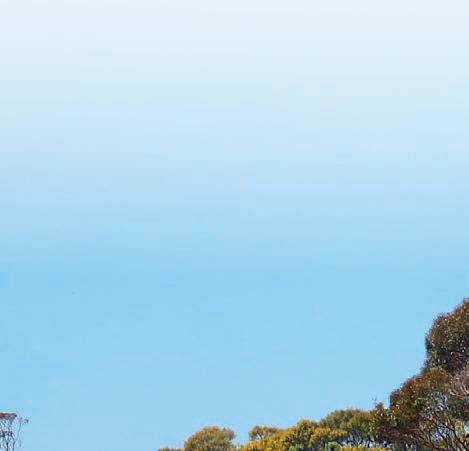



62 ROADS MAY 2024 CONTRACTS & TENDERS
ATLAS COPCO


H HT H HT T
•
•
•
•
•







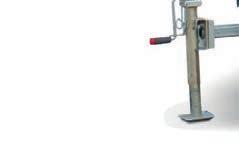





























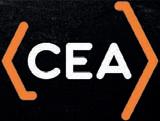
LIKE TO KNOW MORE? SPEAK TO OUR TEAM TODAY PH: 1800 733 782 www.atlascea.com.au The H is built tough with a weather resistant HardHat body and features a user friendly control panel for easy operation. ith a long runtime and e tended service intervals, the Hi ight H is the reliable lighting solution you’ve been looking for. FEATURING:
Dba metres uietest on the market
. lph fuel consumption
hrs continuous runtime
hour service intervals
m2 of light coverage at u es
Dual fork pockets
O mast rotation auto mast down feature •Legendary Hardhat
hoto sensor for auto start auto stop Legendary Terms conditions apply. n road costs not included. peak to your nearest tlas branch for full details and available stock, o er valid until th une or while stocks last. HURRY! OFFER AVAILABLE ON SELECTED STOCK! www.dynapaccea.com.au 1300 788 757 Terms and conditions apply. Offer available through participating Dynapac CEA branches on selected machines, while stocks last. 2023 PLATE CLEARANCE Don’tmissoutonincredibledealsoncurrentfloorstock. Takeadvantageofgreatsavingsandsecureaclassleading Dynapacrollertoday,Hurry,onlywhilestockslast!
•
•
•














www.sami.com.au 1800 BITUMEN
































































































































































































































































































































































































































































